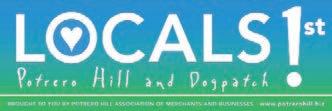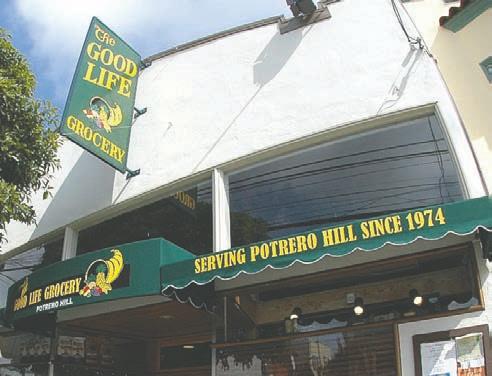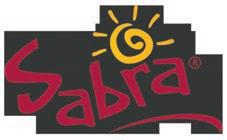










The San Francisco Municipal Transportation Agency (SFMTA) has embarked on an initiative to research and analyze the effectiveness of the Residential Parking Permit (RPP) policy in Dogpatch. Part of the effort may include a pilot project to implement new parking management strategies for a number of blocks within an area bounded by Mariposa and Cesar Chavez streets, Pennsylvania Avenue and Illinois Street. SFMTA and the Dogpatch Neighborhood Association (DNA) have been collaborating to develop the parking plan since January, with some residents opposed to proposals to add paid parking and an RPPmeter overlay to roads between Mariposa and 22nd streets, or place meters in southern Dogpatch.
The RPP program was created in 1976 to protect spaces for residents
PARKING page 25
More than 50 people gathered at Peet’s Coffee & Tea’s Minnesota Street offices to discuss a proposed 24th Street Navigation Center, just west of Warm Water Cove. A significant majority of the crowd raised their hands in response to Dogpatch Neighborhood Association president Bruce Kin Huie’s question asking who in the room was a Dogpatch resident.
Participants expressed deep concerns about the proposed center; the meeting atmosphere was respectful if at times tense. Rand Hoffman, owner of Advance Automotive, a car repair shop close by the cove, said he’s worried that siting of the facility would significantly harm his business. A Dogpatch resident, he’s been operating at that site for 14 years.
“If a facility like the Navigation Center is going to be moved to this community, 24th Street is a terrible choice,” Hoffman said. “There are much better options. If those in charge of choosing the loca-
tion and making the center happen would have engaged the community in a forthright manner a more mutually beneficial location could be established.”
One meeting attendee asserted that alternative sites to Dogpatch should be considered, noting that there were homeless programs located South-ofMarket and in the Haight, but none in the City’s far west or northern neighborhoods. Sam Dodge, director of the Mayor’s Housing Opportunity, Partnerships and Engagement office, who led the meeting, explained that he was looking for under-utilized sites owned by public entities, such as the California Department of Transportation. He didn’t identify any other locations, other than noting that the Presidio was “too expensive.”
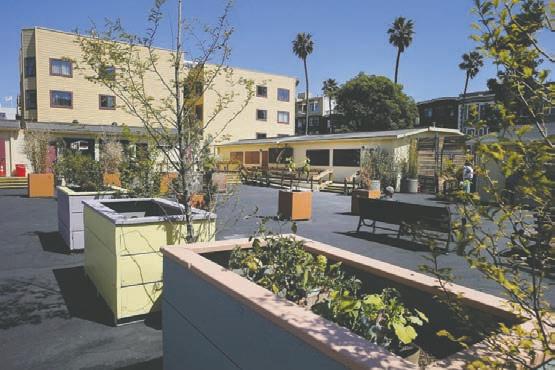
Huie also believes that the City should actively explore other locations. “The current proposed site at 24th Street adjacent to Warm Water Cove is inadequate for the homeless population the City wishes to serve,” he said. “A list of seven sites within the neighborhood and outside have been suggested to date. Neighbors and local businesses look forward to a genuine effort by all involved to consider all possible alternatives to the current proposal.”
In many ways Potrero Hill exemplifies San Francisco as a whole, particularly in terms of its population mix and income. It’s not predominantly European-American, AfricanAmerican, or any other ethnicity; not all wealthy, nor all poor. In addition to its demographics, the 94107 zip code mirrors the City in how and at what age its residents die.
City residents are older than most Americans when they die. Mortality data for 2000 to 2007 indicates that on average San Franciscan women live 3.2 years longer than the average American female; San Franciscan men survive 2.6 years longer than the average U.S. male. When City dwellers do die, the most common cause is cardiac ischemia: decreased blood flow and oxygen to the heart.
Black San Franciscans have a shorter life expectancy than other residents. They also die earliest of
all ethnicities when it comes to the vast majority of causes of mortality, including, for men: violence, cardiac ischemia, poisonings and HIV; and, for women: cardiac ischemia, poisonings, diabetes and breast cancer, according to the California Department of Public Health (CDPH).
Not much about what causes San Franciscans to die has changed recently. Over the last decade and a half, however, there’s been one dramatic, positive, development: the decline of acquired immunodeficiency syndrome. “HIV is no longer in the City’s top 10, and that’s mainly due to prophylaxis,” said Michelle Kirien, San Francisco Department of Public Health epidemiologist.
The drop in HIV-related deaths is stark. From 2000 to 2003, the disease was one of San Francisco’s leading causes of mortality, second only to cardiac ischemia as a cause
In response to participant questions about potentially dangerous behavior by Navigation Center clients, Dodge promised that a risk management plan would be shared with the public, as would the request for proposal issued to select a nonprofit to run the site. He explained that robust staffing and the ability for residents to remain at the facility during the day would mitigate disruptive behavior.
The meeting was prompted, in part, by the San Francisco Board of Supervisors’ unanimous passage of a declaration of a shelter emergency in late-March. The declaration designated the City’s need for homeless shelters as akin to a shelter crisis during a natural disaster, allowing the municipality to seek federal assistance and move more quickly to allocate public land for navigation centers.
According to a December 2015 report from the Controller’s Office, San Francisco’s first navigation center opened in March 2015 at 1950 Mission Street. In its first six months it served 212 clients, most of who were referred by the San Francisco
I was born into privilege. Not the wealthy kind. My parents, struggling to raise five kids on my father’s aerospace engineer’s salary, cut coupons, dressed us in off-brand on-sale items, and got by on powdered milk, bulk cereal, and day-old bread. My privilege was of a superior kind, one that serves as a kind of international passport and entry card into the lobbies of five star hotels even when I just had coins in my pocket. I was born male, White, and American.
Being male, White, and American has lost some of its luster over the past decade or two, at least for those with less than a college education. But for most of my life, and since the founding of the nation, it’s packed a powerful punch, enabled me to comfortably engage in situations that would seriously frighten, if not truly threaten, a woman or person of color.
A male friend and I had tea with Bedouins deep within the Israelioccupied Sinai desert, many miles from any formal outpost. I briefly tangled with riot troops in Paris during student protests, evoking the incantation “je suis Americain!" to usher them on their way. After I touched a Miami police officer on the chest as I tried to explain my side of the story of an altercation, he didn’t pull his gun or a Taser, though he did quickly frog-march me over to his patrol car.
The protective shield I wore as a result of my privilege muffled my ability to understand that other people, particularly women, don’t have it. It also caused me to do stupid things. I was so accustomed to walking down dark alleys anytime and anywhere, I was mildly surprised when a Peace Corps friend balked at doing so along a dusty, trash-strewn alley in a Senegalese village. She carefully explained to me that women just don’t do that, a lesson my wife had to repeat years later when I suggested a late-night stroll in the Tenderloin. Being male, White, and American means possessing a level of power, as well as hubris, which others don’t have and can’t afford.
I’ve been confronted with personal powerlessness enough times to know how awful it feels. My privilege frequently fails when confronted with a bureaucrat over a sticky issue at an airline or bank counter, or anytime I seek customer service from Comcast. I’ve felt my influence drain away, like blood being extracted by a vampire, when I’ve tried to advocate that my daughter get the help she needs from the San Francisco Unified School District. Feeling powerless sucks. Being powerless is much worse.
Although they all have their magic, of the triumvirate of attributes gender trumps the other two. Throughout the globe being female comes at a cost. Women are covered, restricted, enslaved, paid less, and far more likely to be crime victims than perpetrators relative to men. In the United States there are constant attempts to tell women what they can or should do with their bodies, including insistent media images that undermine girls’ self-confidence and sense of autonomy, periodic sterilization of prisoners, as uncovered by the Center for Investigative Reporting, and unrelenting attempts to strip women of their reproductive rights.
Gender is power. And it shouldn’t be. Being a man – or White, or American – should confer on me no greater advantage than being a woman. We should all be comfortable walking wherever we choose: on a remote road or one in our own City, into a job that seems to be reserved for men, or into a Planned Parenthood clinic. I don’t want to give up my power. But I do want share it. And, anyways, it shouldn’t be my, or any man’s, choice.
With great appreciation for the Mary Wohlford Foundation for supporting this issue.

President Barack Obama made a fundraising visit to the Arkansas Street home of Steve Phillips , former president of the San Francisco Board of Education , and his wife, the philanthropist and heiress Susan Sandler . Preschoolers waited on the sidewalk to see the commander in chief go by, as did nearby residents. “We were really lucky,” said 80-something Marjorie Marie-Rose , who lives next door to the Phillips/ Sanders, and waited two hours to greet the president. “For four days I had wanted to make a soup,” said Marie-Rose, who is related to Bonnie Raitt, “and I wasn’t sure I could make it, I was so tired…But I put on some lipstick – that’s vanity – and joined a group of my neighbors to wait. You couldn’t get on the block unless you lived there. After Obama got out of the car, he walked right by where I was standing. He shook my hand, and I told him I made the best chocolate cake ever, with Belgium chocolate, and took it to the senior lunch to celebrate when he was elected. He thanked me.”
Last month, the San Francisco Chronicle reported that District 10 Supervisor Malia Cohen was gifted a roughly $10,000 six-day trip to Israel, courtesy of the American Israel Public Affairs Committee . “With the number of Jews we have living in San Francisco, developing a relationship with the state of Israel, I think that’s a worthwhile trip to make,” Cohen was quoted as saying. Jews represent a couple percent of San Francisco’s population; there are far more Irish- and Mexican-Americans in the City. But perhaps those groups don’t pay for free trips. Likewise, the AIPAC junket would appear to be Cohen’s second tour of the Holy Land; she previously journeyed there on the Jewish Community Relations Council’s dime. Cohen claimed that the excursion was valuable given her role on the San Francisco Retirement
Board , alluding to efforts to pressure municipalities to divest from Israeli investments. But if that’s the case, going on multiple trips paid for by pro-Israel organizations would seem either to be more like a shakedown of these entities – provide a trip or I’ll vote against you – or an odd way to conduct some kind of neutral investigation. Hypocrisy in politics? Say it isn’t so…
The Sandwich Shop reopens this month at 2071 Third Street… The View’s distribution boxes have been tagged, stickered, trashed, and spun-around. In March came a new insult: arson. According to Officer Steven Filippi , “At approximately 0235 hours Officers Castenada…and Ramoso…broadcast that they viewed a fire at the location of 18th…and Connecticut streets in the Bayview Police District. Upon arrival… Officers…stated the following… They observed a cloud of smoke emerging from The Potrero View newspaper distribution box in front of 1469 18th Street. Officer Ramoso stated he opened the distribution box and observed approximately the top ten newspapers had been set on fire. Ramaso stated he reached into the distribution box and took the burning newspapers out before they could engulf the box. Based on my investigation, I formed the opinion that an unknown suspect lit the newspapers on fire and used them as an accelerant in an attempt to destroy the distribution box and a violation of arson had been committed.” Perhaps a disgruntled reader didn’t like one of the paper’s articles…
Last month a new park, Angel Alley, opened on Tennessee Street between 22nd Street and Tubbs. The half-block long dead-end alleyway serves as a pedestrian and bicycle shortcut to Dogpatch’s main

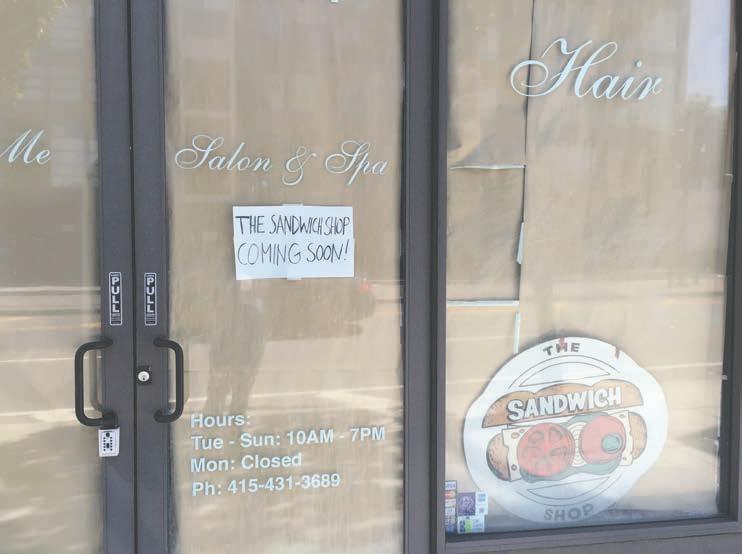

Editor,
the facts would only confuse formulaic policy.
Contrary to “No Pesticides Used in Potrero Parks, According to Environment Department,” February, Aquamaster – Glyphosate – was used in Franklin Square on May 3, 2014. Other than that, your information is correct, Potrero Hill was spared.
Tom Borden PortolaEditor,
I’m horrified with the cover story of your April Fools’ issue, poking fun at domestic abuse (“Mayor Resigns, Appoints Mirkarimi’s Wife”). I love a good April Fools’ joke, and a joke the other 364 days of the year, but to make light of the horror faced by millions of women – and men – in this country every year is simply disgusting.
Regardless of what transpired between Mirkarimi and his wife, to suggest that a woman could hold the mayoral office because she's experienced physical abuse is deplorable. And not at all funny. And misogynist to boot.
I really cannot wrap my head around how in 2016, and in San Francisco of all places, an editorial staff could stand behind such low thinking. On a typical day in America, 20,000 phone calls are made to domestic abuse hotlines. One in three women will be victims of violence from a domestic partner in their lifetimes. What kind of people are you to think that this was printable? Have you no mothers, sisters, wives or daughters?
You should all be ashamed of yourselves. You owe this neighborhood, this City, abuse victims, and Ms. Lopez a printed apology.
Mary Randolph Norton Long-time Potrero Hill Resident
• Extend i mmunity t o a ll w ho w ere forced t o prosecute t he former sheriff so that we can determine exactly what former Mayor Lee’s political motives were in prosecuting my husband. In this way, we might finally learn why the mayor’s personal security officers announced an evacuation of only the mayor from the witness stand after a reported “bomb threat” just when he was mumbling and fumbling under attorney Sheppard Kopp’s withering cross-examination during the Ross Mirkarimi Ethics Commission hearing. Yet, the rest of the packed hearing room and all of City Hall were never alerted and allowed to remain in place.
• Make i mmediate c hanges i n t he Police D epartment t hat’ll e nd t he “firing squad” approach to community policing supported by the Police Officers Association president.
• End the practice of more lobbyist- and developer-subsidized overseas mayoral visits to China, Brazil, China, Paris, China, Ireland, China, London, China, South Korea, China, India, China, Israel, China, the Philippines, and China in order to allow the mayor to visit San Francisco neighborhoods, where citizens are overwhelmed with issues ignored by Mayor Lee.
• Require t hat p ublic c osts a ssociated w ith m ajor e vents l ike t he America's Cup, Central Subway, and Super Bowl be accurately published before the event, with a specific plan on how to pay for them.
• Immediately end all restrictions on the Board of Supervisors' right to ask only written, previously screened questions of the mayor during “Question Time” each a month.
• Commit t o c ommunicating a ll p olicies t hrough n eighborhood n ewspapers like The Potrero View, where San Franciscans can always depend on being told the truth, except for an innocent typo or two.
• Require all techies to ride only Muni to Ron Conway’s house, where they’ll be eligible to board Google and Bauer Buses driven by Teamster drivers.
• Instruct Ron Conway that he must forsake his often-repeated promise to drive Aaron Peskin out of politics, because it’s not fair to Julie Christensen.
Editor,
I love humor, including sarcasm, but your article about Ed Lee's 'replacement' was neither. It was totally insensitive to the huge problem that exists today with domestic violence. Taking a beating is no joke even in an April Fools’ article. Give a little thought to how the many victims would feel reading your 'story'.
Gerry Brinton
Editor,
Hahaha! Great edition in April. I didn't realize it was an April Fools’ joke until I started reading the front page articles a bit further. You should have heard me ranting about the Ed Lee headline to my husband. He’d already read it, realized the joke, and decided to let me go on for a few minutes.
Thanks for making my day!
Editor,
Katie Shumays
"Gullible" on Kansas Street
Your April Fools’ front page was priceless. Thank you! I’m sure you’ll get some complaints from the too-politically-correct-to-have-a-sense-ofhumor wing. Wanted to let you know that some of us thought it was great!
Barbara Heroux
Rhode Island Street Resident Since 1983
• Remove E d L ee’s b an o n t he S heriff’s office i nteracting w ith t he Mayor’s office, so that newly elected Sheriff Vickie Hennessey can help San Francisco continue the high performance level that led to the prestigious 2014 Harvard Innovation in Government and the awarding of the $100,000 to the office so admirably led by former Sheriff Ross Mirkarimi.
It’s my humble view that this agenda, together with the newly energized Board of Supervisors, will put an end to all “beatings” endured for too long by me and the people of San Francisco from the now retired mayor and his henchmen.
Eliana Lopez Mayor Designate, San Francisco
The month of June is known for weddings and primaries, both of which can lead to happily ever after or quite the opposite. The June 7 election is marked by a handful of state and local propositions – most of them about spending taxpayer money – and a few hotly-contested political races – only one of which, for president, is likely to have much meaning. Below is our View of things.
Editor,
It was a delightful, and hilarious, surprise to read of my appointment to replace Mayor Ed Lee in the April Fools’ edition of The Potrero View What a scoop! And to think that it all happened without any ruse, like a “Run Eliana Run” committee headed by former Secretary of State Hillary Clinton and Senator Bernie Sanders, who strongly support my commitment to truth and transparency in San Francisco government.
One of my first promises to the people of our great City will be to serve out the remainder of Mayor Lee’s term and allow the voters – not Willie Brown and Ron Conway – choose the next mayor. I will not be a candidate, as my one-woman play, What’s the Scandal, is now being made into a movie after a successful run on Broadway. However during the year that I’ll serve as acting mayor, I’ll:
• Offer a n i mmediate pa rdon t o a ll t hose w ho, for p olitical r easons, refused to believe that my husband and I experienced an old-fashioned marital argument, not domestic violence. over a visit to Venezuela with my son, and thus forced our family to be separated for six months because they knew what was best for this newly arrived immigrant mother and were afraid
Proposition A, Public Health and Safety Bond. Should $350 million be spent “to finance construction, acquisition, improvement, seismic strengthening and betterment of critical community and mental health, emergency response and safety, and homeless shelter and service facilities?” Who could be against the “betterment” of “critical” things? While generally supportive of spending money on beneficial infra-
structure, the View wonders whether the City, riding high on a roughly $9 billion budget, might find some spare change to pay for these types of investments using existing resources. Our recommendation: Meh.
Proposition B, Recreation and Open Space Fund. The Open Space Fund, approved by voters in 2000, is provided 2.5 cents for every $100 of assessed value of property tax, with additional General Fund (GF) monies directed to the Recreation and Parks Department as determined annually by the Mayor and Board of Supervisors. Under Proposition B, a baseline appropriation for Rec and Park and the Open Space Fund would be mandated, pivoting off of fiscal year 2016 GF expenditures of $64 million. The Open Space Fund, set ELECTION page 21
With appreciation to the MARY WOHLFORD FOUNDATION, for supporting this issue.
Over the past year alone, a cascading set of trends has prompted the closure of 10 Bay Area hospitals outside San Francisco, according to longtime health care consultant Walter Kopp. Reductions in Medicare and Medi-Cal rates, a shift to greater reliance on outpatient facilities bolstered by Obamacare rewarding ambulatory care more heavily than hospital stays, with penalties for readmissions, and flat wage growth among low-income households contributed to the closings. Hundreds more facilities are expected to follow nationally. According to Modern Healthcare , rural areas, which are especially dependent on Medicare patients, have been hardest hit.
California hospitals have the added burden of complying with Senate Bill 1953, which requires all hospitals in the state to be retrofitted to withstand a large earthquake by 2030. California Health Care Foundation researchers estimate that nearly half of the state’s hospitals are affected by the law, with the ensuing construction costs representing an unprecedented expense.
Financially troubled hospitals with few prospects of attracting the investments needed to make required upgrades have been steadily folding or merging with larger health care groups.
While the health care sector is being disrupted nationally, San Francisco is in the midst of a hospital construction boom. The rechristened “Zuckerberg San Francisco General Hospital” recently completed a $1 billion renovation. Three other health care giants –Kaiser Permanente, Sutter Health, and the University of California, San Francisco – have invested nearly $20 billion in the City over the last two decades, according to medical journalist Chris Rauber. And the Hospital Council of Northern and Central California estimates that at least another $5 billion will be needed to complete new health care projects before the decade is out.
“California remains the most active health care construction market in the United States,” said Kevin Day, a health care architect and associate vice president at HGA Architects and Engineers in San Francisco.
California is among the most abortion-friendly of the states, with the fewest restrictions or laws curtailing the right to have the procedure. The number of abortions nationwide dropped by roughly 12 percent between 2010 and 2014, according to the Associated Press. However, California’s abortion rate experienced even more significant declines; women in the state today are about half as likely to get an abortion as their peers 20 years ago.
There’s no central reporting agency or requirement to account for abortions in California. According to the Guttmacher Institute, a half-century old research institution that works to advance sexual and reproductive health and rights, the state’s abortion rates declined rapidly from 1991 to 2011. Investigators cited increased use of birth control and improvements in birth control efficacy for the trend.
In 2011, 181,730 women obtained abortions in the state, 23 abortions per 1,000 women of reproductive age, though the data doesn’t account for interstate travel for abortion services. Overall, abortions in California represent 17 percent of all such procedures in the United States.
According to the California Department of Health Care Services’ Research Analytical Studies Section, in 2010 San Francisco accounted for just two percent of the 64,234
These large capital expenditures are being made even though the number of hospital beds in the City is more than ample, even excessive for a population of San Francisco’s size. At nearly 2,900 beds, San Francisco, arguably one of the state’s most health conscious cities, has double the statewide average for beds per 1,000 residents. In California, advanced technology and improved care coordination has resulted in significant efficiencies, reducing the state’s hospital bed average to 1.5 beds per 1,000 residents, down significantly from the national average of three beds per 1,000 residents, according to World Bank and Dartmouth Atlas data.
A significant portion of health care capital investments are directed at creating regional centers of health excellence in San Francisco, providing centralized, sophisticated, medical services. According to Kopp, tourists will be the primary beneficiaries of the City’s health care upgrades. Not those that visit San Francisco to eat chowder and walk along Fisherman’s Wharf, but ones seeking specialty health care: organ transplants, cancer treatments and other complex interventions.
Changes at the St. Luke’s campus of California Pacific Medical Center-Sutter Health exemplifies
another health care trend buffeting the City: the upscaling of services. St. Luke’s historically catered to a sick population of mostly poor and working class San Franciscans. As the neighborhood around it gentrified, the facility merged with Sutter Health, a move that saved St. Luke’s from closing. According to the New York Times, from its emergence more than 100 years ago as a hospital founded by Episcopalian nuns to serve as an almshouse for the poor and suffering, St. Luke’s has become a go-to care center for the young, upwardly mobile, residents now occupying the historically immigrant neighborhood.
Taxpayer dollars – city and state – support some health care capital projects. However, the biggest drain on government coffers stems from the fact that hospitals’ activities are often tax-free. Since health care institutions were founded as refuges for the poor, destitute and unwell, they were granted nonprofit status to enable them to carry out their charitable mission more than a century ago. But a 2010 to 2013 investigation by the Greenlining Institute indicated that while nonprofit hospitals received $3.27 billion per year in government subsidies and benefits, they provided just $1.43 billion in community benefits.
abortions provided under Medi-Cal, which offers no or low-cost health coverage to low-income families. Los Angeles was responsible for the lion’s share, 34 percent, Orange County, six percent, and San Bernardino, Santa Clara, Fresno, Contra Costa, San Diego counties each representing roughly five percent.
One of the biggest factors in declining abortion rates is improved access to effective contraceptives. Oregon and California recently enacted laws that allow women to obtain birth control pills without a prescription, directly from pharmacies over-the-counter, and, in California, without an age restriction. Research indicates that women are more likely to use birth control and less likely to have unintended pregnancies when contraceptives are easily accessible, both financially and logistically. A 2015 study published in Contraception found that “21 percent of lowincome women at risk for unplanned pregnancy are more likely to use the pill if it is available without a prescription.”
According to California Abortion Clinics, one out of three women will have an abortion by age 45, 58 percent of women having abortions are in their 20s, 61 percent have one or more children, 85 percent are unmarried, 69 percent are economically disadvantaged, 73 percent report a religious affiliation, 36 percent are European-American, 30 percent are African-American, and 25 percent are Hispanic.

San Francisco is home to three clinics, located in Bernal Heights, Potrero Hill and the Haight, that offer abortion services. Two other facilities, in the Outer Mission and Union Square, vend anti-abortion messages in the guise of providing family planning assistance.
Variously called “crisis pregnancy centers” (CPCs), “pregnancy counselling centers,” “limited service pregnancy centers” (LSPCs) and “pro-choice counselling clinics,” anti-abortion facilities market themselves as offering options to pregnant women, including abortions. In reality, however, they’re typically faith-based, anti-abortion and only provide narrowly-defined counselling, “emotional support,” and “community resources” to women seeking their help.
CPCs try to persuade women who are considering an abortion to carry the fetus to term. According to NARAL Pro Choice California and other pro-choice organizations, CPCs’ apply emotional abuse, harsh judgement, and lies about abortion’s side-effects to pressure women into changing their minds. One NARAL investigator, posing as a pregnant woman in need of help, was told to “stop whoring around.” Other women have been stalled through the use of “required” check-ins to make them wait long enough that an abortion was no longer possible.
The San Francisco Pregnancy Information Disclosure and Protection Ordinance, passed in 2011, forbids clinics from presenting false
or misleading advertising or to imply that they offer services that they don’t. The order requires facilities to explicitly state whether or not they provide abortion services or referrals. CPCs claim that such ordinances violate the First Amendment, a freedom of speech argument that caused similar rules in Baltimore and New York to be repealed.
First Resort Pregnancy Center, a Bay Area chain that has rebranded itself as Third Box Pregnancy Clinics, and now Support Circle Clinics, challenged San Francisco’s ordinance in federal court. In response, City Attorney Dennis Herrera argued that First Resort’s advertising is “an insidious practice that victimizes women who are, in some instances, already victims. It’s especially problematic because these centers can cause interfere with women’s timesensitive, constitutionally protected right to reproductive choice.” In 2015, the law was upheld by U.S. District Judge Saundra Brown Armstrong of Oakland.
“The issues here are about accuracy in advertising and making sure that women aren’t misled,” said Amy Everitt, NARAL Pro Choice California director. “Regardless of where you stand on abortion, most people can agree that women should get accurate information when looking for information about their health-care options.”
In 2015, California became the first state to require CPCs to post information about free and low-cost public programs for family planning, abortion services and prenatal care. Assembly Bill 775, the Reproductive FACT Act,
marks reproductive rights advocates’ first success at state regulation of CPCs. However, NARAL discovered through undercover investigations that not all CPCs are abiding by the law. “We have really progressive, really fabulous laws,” said Everitt. “But if they aren’t enforced they don’t mean anything.”
NARAL investigators visited 43 of California’s 228 CPCs, and found that regardless of a service-seeker’s situation – whether or not she was financially stable, in an abusive relationship, in school, or mentally prepared to go through with the pregnancy, among other factors – CPCs’ unwavering message was to complete the pregnancy. NARAL observed that CPCs’ staff seemed to all be reading from the same script, conveying consistent falsehoods about abortions that the medical community has rejected. Of the CPCs NARAL visited, 46 percent claimed falsely that abortion and breast cancer are linked; and 35 percent asserted that abortion causes fertility issues. A 2008 American Psychological Association study, as well as a 2013 University of California, San Francisco report, concluded that a woman who is forced to carry a fetus to term will suffer more mental health problems than one who decided to have an abortion.
Support Circle Clinic maintains an office at 450 Sutter Street, with two others located in Oakland and Redwood City. According to case files from First Resort’s – Support Circle’s predecessor – AB 775 challenge, the clinic believes that "…abortion harms the mother and father, their families, and the unborn
child." Its mission, as stated in its articles of incorporation, is to “build an abortion-free world.” Conversely, Support Circle indicates on its website, buried in its FAQs, that it doesn’t perform or refer for abortions, and that it’s a Christian organization. Support Circle also asserts that Americans should be “disturbed” and “appalled” by the “high incidence of abortion.”
First Resort was one of many CPCs that paid for Google ads to ensure that they popped up when “abortion” was searched. NARAL persuaded Google to remove the ads after it found that 79 percent of CPCs that purchased advertisements didn’t provide abortion services. NARAL also found that many CPCs don’t disclose their religious affiliation.
Alpha Pregnancy Center operates at 5070 Mission Street. An Evangelical Council for Financial Accountability report on the facility states that it’s a “pro-life center” offering women “alternatives to abortion.” However, Alpha’s website doesn’t identify what services it provides, and doesn’t reveal its religious affiliation.
More than 200 state restrictions on abortions have been enacted over the past six years in both “red” and “blue” states. Clinics in conservative states face hostility from state health departments, which delay building permits. They can have difficulty finding contractors, who are oftentimes stigmatized and boycotted. Oklahoma and Kansas prohibit publicly-funded

Securing answers from San Francisco law enforcement agencies – which are engaged in internecine bickering over a host of issues, including allegations of racial profiling by police officers – about how well they respond to incidences of rape has proven as difficult as it was to determine their success in solving the City’s murder cases. (See “Better that 50/50 Chance of Getting Away with Murder in San Francisco,” October 2015).
“We cannot determine how often a rape occurs in San Francisco because we would not be aware of it unless the victim comes forward and notifies us,” said a San Francisco Police Department spokesperson, unhelpfully. “Your best bet would be to contact the District Attorney's office to see their prosecution rate of rape cases. Cases can be dropped for a multitude of reasons, including the victim no longer wanting prosecution.”
The DA’s spokesperson countered with, “In terms of rate of arrest that is a question for SFPD. You can check out COMPSTAT for number of reported incidents.” According to the Computer Statistics database, in 2015, there were 344 reported rape cases in the City. The DA went on to state, “If your question instead is when SFPD solves a case and presents it to us for prosecution, how often do we charge it, that’s a very different inquiry. In 2015 our office had sufficient evidence to take action in 72 percent of the cases presented to our Child Abuse & Sexual Assault Unit.” Left unanswered was the question the View had asked: when a rape complaint is lodged in the City, how often is it resolved?
In response to political pressure, SFPD does appear to have made progress processing rape kits. A rape kit is a container that has a
checklist, materials, and instructions, along with envelopes and containers to package DNA specimens obtained during a sexual assault forensic exam.
It may include bags and paper sheets for evidence collection, envelopes, materials for blood samples, and swabs.
In 2010, the City enacted an ordinance requiring all rape kits be tested within 14 days of receipt. In 2013, ABC 7 news reporters discovered that the San Francisco Police Department hadn’t gone back and processed kits collected before the ordinance took effect. In response to public outcry, the SFPD conducted an audit in 2014 which identified 753 pre-2010 untested kits that fell within the statute of limitations of 10 years.
“The Department had previously used the number 753 [of untested kits], but later determined that of the 753, 76 of those kits had previously had some level of DNA testing done,” Officer Grace Gatpandan said, which lowered the number of untested kits to 677.
To test the DNA in the rape kits, SFPD contracted with a private lab, Virginia-based Bode Cellmark Forensics. Ninety-seven percent of the 677 kits contained sufficient evidence to merit uploading the resulting data into the Federal Bureau of Investigation's combined DNA index system (CODIS). CODIS relies on two indices to generate investigative leads for crimes that contain biological evidence. The forensic index consists of DNA profiles created from biological evidence left at crime scenes; the offender index contains DNA profiles of individuals convicted of violent crimes. CODIS compares a target DNA record of an identified suspect against the DNA records contained in the database.
The match of the forensic DNA record against the DNA files in the database may be used to establish probable cause to obtain an eviden-
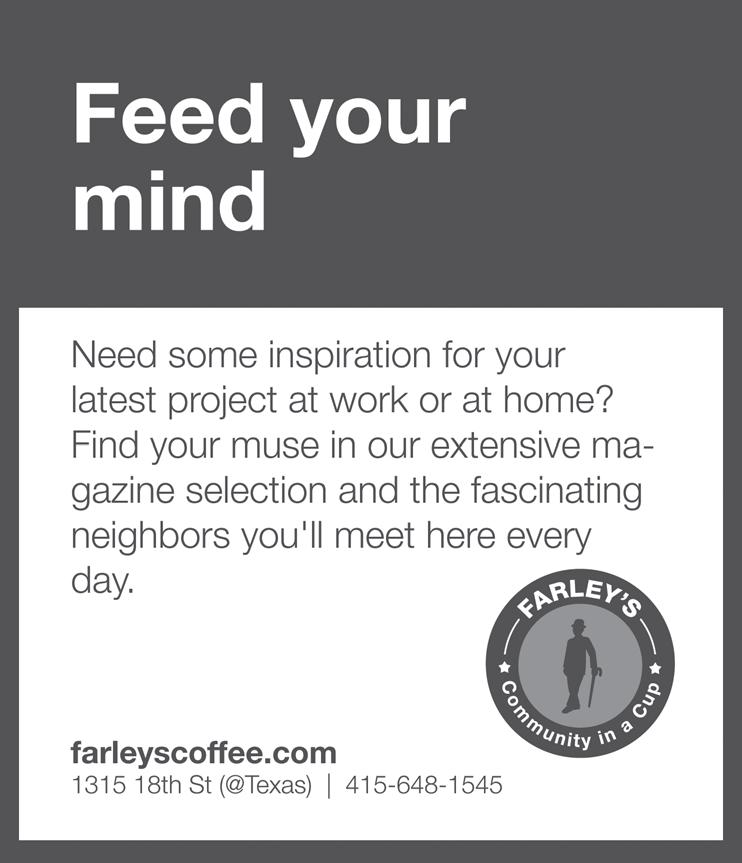
tiary DNA sample from a suspect, with the resulting evidence available to be presented in court, according to the FBI's website.
Of San Francisco’s 677 kits, in 231 DNA was obtained from biological material at the crime scene that could be attributable to a presumed perpetrator; 119 resulted in “hits” or matches in DNA samples. “There are 55 additional kits in various states of review for evaluation and possible uploading to CODIS,” Gatpandan said.
The City has another 513 kits that relate to crimes that are beyond the statute of limitations. In 2014, SFPD said it wouldn't test those kits, but has since reversed their position. “Of those items submitted, 43 resulted in some type of response from lab testing,” Gatpandan said. “There are 405 in process at the contract laboratory. Sixty-five are pending. To date, there are no CODIS entries from these items.”
SFPD declined to provide further information. “There is a CODIS document containing identifying information of suspects; however, that document is exempt from disclosure as it contains information that, if released, would compromise ongoing investigations and the persons listed may be suspects only and that information is not subject to disclosure,” Gatpandan said.
Policymakers continue to pay attention to rape kit backlogs. In lateFebruary, Assembly member David Chiu (D-San Francisco) and Attorney
General Kamala D. Harris introduced a bill that would provide greater transparency for rape survivors, policymakers and the criminal justice system around sexual assault cases. Assembly Bill 1848, co-authored by Assembly member Autumn R. Burke (D-Inglewood) and Assembly member Bill Quirk (D-Hayward), would direct local law enforcement agencies to track the progression of rape kits and report their data – such as the number of kits they receive – to the U.S. Department of Justice.
In California, no comprehensive data is available about the number of sexual assault evidence kits that local law enforcement agencies collect annually, or how many of those kits are analyzed. Further, no information is available that details why some sexual assault evidence kits aren’t analyzed.
“Survivors of sexual assault who are submitting sexual assault evidence kits aren’t getting the answers they need and deserve,” Chiu said in a press release. “To get at the crux of the backlog problem, we need to know how many kits are collected each year, and if they’re not analyzed, we need to know why. This data will help shed a light on what areas of law enforcement need to change and whether or not they need more resources to get the job done.”
Last month, the San Francisco Police Commission directed SFPD to submit public reports twice a year documenting the department's collection and analysis of rape kits.

Dr. Nancy Milliken, founder and director of the University of California, San Francisco’s National Center of Excellence in Women’s Health, has spent her career advancing the health and well-being of women. A professor emerita at UCSF’s Department of Obstetrics, Gynecology and Reproductive Science, and previously vice dean of UCSF’s School of Medicine, over her thirty-plus-year career Milliken has treated hundreds of patients.
Milliken first became interested in women’s health in her senior year at Harvard University, when she was studying history. “I was getting my reproductive health care from doctors that at the time were very patronizing, very condescending, and who did not share any information,” said Milliken. “It was a negative experience. So I had that on the one hand. On the other hand, I joined a women’s “self-health” group which was part of the emerging women’s health movement. We shared information that we couldn’t get from the medical system. It was that experience that made me say, “Things can be better. Things should be better. I would like to be part of that transformation of medical care.”"
The Cambridge movement Milliken joined started out as the “Doctor’s Group,” changed its name to the “Boston Women’s Health Book Collective,” and finally came to call itself “Our Bodies, Ourselves.” The group ultimately retitled a course booklet about women’s health that its members wrote and edited, publishing it as Our Bodies, Ourselves
After Milliken graduated from Harvard, she took the science courses necessary to attend medical school at Stanford University. She received her MD from Duke University in 1981, followed by a four-year residency in obstetrics and gynecology at Pennsylvania Hospital in Philadelphia.
“I found that I loved taking care of women going through transformative life events and giving them holistic and compassionate care,” said Milliken. “One of the things that was troubling me at the time was nationally there had been several instances of doctors and hospitals seeking court orders to force women to undergo Caesarean sections. A fellowship in medical ethics brought me to the Bay Area to explore this.”
After Milliken served as a UCSF Robert Wood Johnson Scholar for two years, the university asked her to join the faculty. She’s been there ever since.
Milliken has received many prizes, including the UCSF Chancellor’s Award for the Advancement of Women in 2002 and the Academy of Women’s Health 2015 Bernadine Healy Award for visionary leadership in women’s health. In 2000, Milliken co-founded the annual San Francisco Young Women’s Health & Leadership Conference with Congresswoman Jackie Speier (D-CA, 14th District). Milliken simultaneously launched a mentorship program at the university to encourage young women to enter the field of women’s health. To date, more than 9,000 women have participated in the program.
“I’m a lifer. I think that UCSF is a remarkable community of really committed individuals who want to improve the world,” said Milliken.
Milliken helped found the UCSF National Center of Excellence in Women’s Health in 1996. “I was part of a group of fabulous people from many disciplines interested in women’s health. The Center is a collaborative effort of like-minded professionals,” said Milliken.
The Center is one of 19 facilities located across the country designated as such by the Office on Women’s Health, part of the U.S. Department of Health and Human Services. It’s located on UCSF’s Mount Zion campus. It

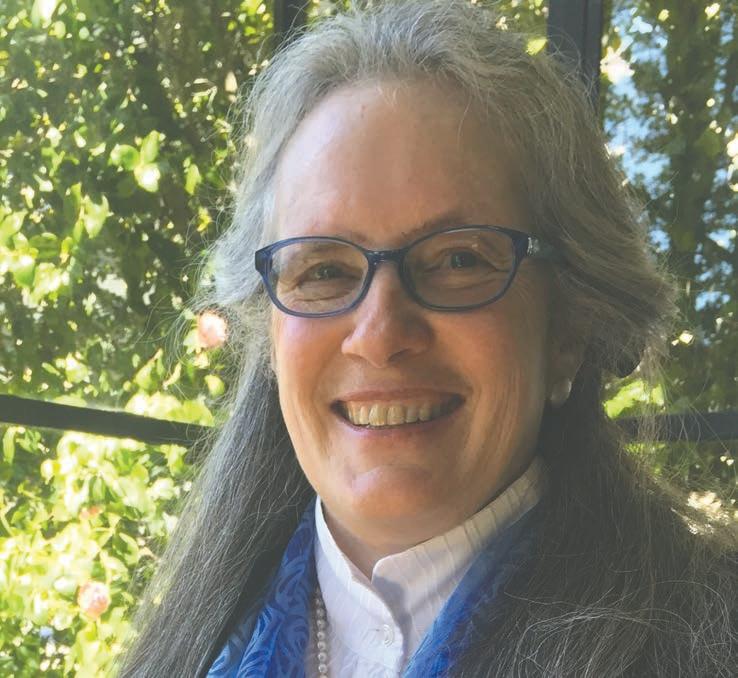
offers comprehensive health care to women, including abortion services. Its core clinical program focuses on obstetrics, gynecology, and internal medicine. The Center also provides referrals to specialists in fertility, cancer, reproductive health, and other maladies. This month it celebrates its 20th anniversary.
According to Milliken, women’s health has unique challenges. “We embrace the diverse choices that women are making.” she said. “We provide confidential care for what are really personal decisions, including sexuality; whether, when and with whom to have children; and mental health and end of life care. Our job is to provide expertise, share information and facilitate the right health and healthcare decisions for each individual.”
Understanding women’s health today requires considering issues of sex and gender. “Sex refers to differences in our DNA. Every one of our cells has a sex, XX or XY. Gender is a way in which we live in the world and how the world as a result treats us. Both sex and gender impact our health,” said Milliken. “If we address sex and gender in our approach toward care, research, healthcare and training, we will be able to provide appropriate care to all going forward.” Milliken is proud
that in 2015 the center established a Transgender Healthcare Navigation program to improve care coordination for transgender individuals.
Milliken, who lives within walking distance of the Center, said she’s lucky to work in San Francisco. “The Bay Area is full of innovative thinkers who are advocates of women’s health, reproductive rights and choices,” said Milliken. “We have a vast array of community organizations that are making a difference in women’s lives. We have politicians who care about policies being based on evidence. In general, the Bay Area’s been very ahead of the curve in women’s health. My goal is to help keep it there. I think we will, because we have so many incredible powerhouses here to advancing women’s health science, services and policy.”
Milliken’s current goal is to assist those who follow her in “continuing advances in women’s health across the lifespan. The most important thing for me at this stage of my career is to support the potential and success of the next generation. My advice to those who want to work in women’s health is to follow their talent and their passion. They should recognize that they will be most successful if they do it in a collaboration with others.”


With this month’s opening of a new nine-story building that includes spacious rooms for labor, delivery, recovery, and postpartum care, Zuckerberg San Francisco General Hospital (ZSFG) combines well-designed facilities with highly committed physicians and impactful community programs that have served women and children from low-income and working-class families for decades.
“I think what makes us different from other hospitals is our ethos about supporting women and helping them make the choices that they want. We have a really good network of support services for patients, including social work and nutrition. It is often hard to get private insurance to cover these,” said Dr. Rebecca Jackson, chief of obstetrics, gynecology and reproductive sciences at ZSFG.
According to Jackson, approximately 80 percent of ZSFG’s patients are covered by Medicare or Medi-Cal. Five percent pay their own bills. The remainder, including undocumented immigrants, are uninsured. Sixty percent of the hospital’s patients are Latino; many of whom speak only Spanish. ZSFG “meets patients where they are,” Jackson said, by having many staff members who are bilingual Spanish-English speakers, with cultural competency serving Latino populations.
“Many of our patients are immigrants, and quite a number of our mothers are isolated. They don’t have a lot of family members and friends around. Some had to come without their other children. It brings up a lot of conflicting emotions. We provide a lot of social support and care,” said Dr. Pooja Mittal, a family medicine physician at ZSFG.
According to a 2014 The New York Times article, ZSFG is women and children friendly. The hospital now features private, art-adorned lactation rooms and a large, open Intensive Care Unit for babies. There are 19 beds and 14 rooms for expecting and new mothers on the old building’s fifth floor; the new structure contains 21 private rooms for this purpose on its second floor.
A 2014 California Office of Statewide Health Planning and Development study found that ZSFG’s approach to labor and delivery resulted in approximately 18 percent of mothers giving birth by Cesarean-section. The City and County of San Francisco
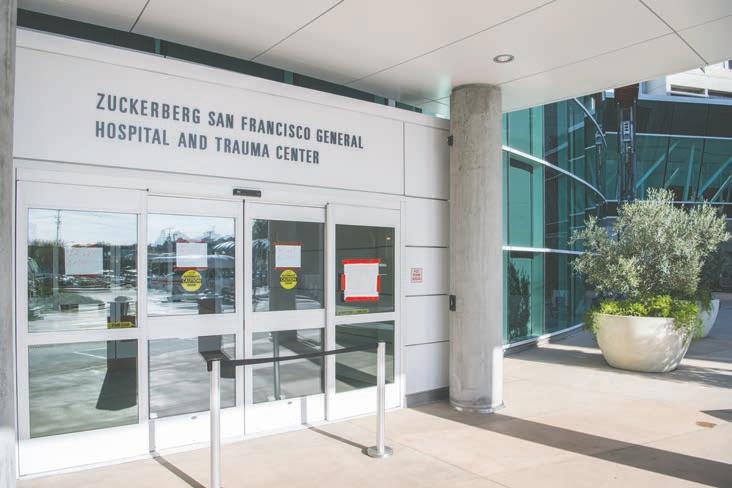
averages a 21 percent C-section rate, California has a 29 percent average, with a 32 percent average nationally. Vaginal births tend to result in no adverse outcomes to babies, and lower morbidity rate for women, according to a 2014 Pacific Business Group on Health report.
Margy Hutchison, a nurse-midwife who has worked at ZSFG for 25 years, said expecting mothers in a normal pregnancy can choose a nurse-midwife or a doctor as a primary caregiver. Women who choose a nurse-midwife are guaranteed that a midwife will be with them during the childbearing process.
As part of the Centering Pregnancy program, ZSFG’s nurse-midwives walk five blocks south to the Homeless Prenatal Program’s (HPP) 18th Street office, where they guide small groups of low-income pregnant women through prenatal support sessions.
“I think the providers at ZSFG truly care. They make an effort to see that the poorest of the poor here in the City receive the same care that somebody who has tremendous means would also get,” said Martha Ryan, HPP’s founder and executive director. ZSFG staff regularly refer Black mothers-to-be to the San Francisco Black Infant Health Program, run by the City’s Department of Public Health, for group classes and support.
According to Dr. Melanie Thomas, a psychiatrist and health services researcher at ZSFG, effective and culturally-tailored mental health services are a critical component of treating women in Potrero Hill and the Mission District, the two neighborhoods the hospital straddles.
“The cumulative effects of chronic stress, which are increased with home-

lessness and other aspects of poverty, are often linked to mental health difficulties,” said Thomas. “Mental health services are undergoing a time of rapid change. Many of the shifts are driven by the Affordable Care Act and the Mental Health Parity and Addiction Equity Act. We’re integrating behavioral health services into primary care. I think we are headed in the right direction.”
“For our homeless population, it’s clear that women and children are especially vulnerable,” said Dr. Melissa Nau, a UCSF faculty psychiatrist who focuses on women’s health at ZSFG. “We work as a multidisciplinary team to connect women in need to appropriate medical, mental health, and social services. Our leadership is committed to helping all providers continue to improve care delivery and find efficient and productive ways to meet our patients’ needs.”
Dr. Misa Perron-Burdick, medical director of ZSFG’s Women’s Health
SFGH page 9
Kiana Underwood’s five-Yelpstar floral design studio, Tulipina, is located on Vermont Street. Tulipina creates floral arrangements for “bespoke weddings,” in which everything is custom-made. “I do lots of weddings and events as well as workshops,” Underwood said. “What I do is pretty unique. I love every minute of it.”
The studio, which doubles as a storefront, opened at the beginning of this year. Underwood located the business in Potrero Hill because she loves the neighborhood and its easy access to transportation; other parts of San Francisco are harder to get to and from. Underwood also likes the Hill’s proximity to the San Francisco Flower Mart.
Tulipina was previously located in Burlingame, where Underwood resides. Underwood started by making flower arrangements for family and friends, launching Tulipina “about five years ago.”
At her Hill space Underwood works on her creations and hosts floral design workshops. Clients, typically brides-to-be wanting floral arrangements for their upcoming wedding, visit by appointment.
“The neighborhood is pretty lovely,” said Underwood. “Everyone is really nice. They come by and talk to me if I’m here.” Underwood is in the studio four to five days a week, when she isn’t traveling to host workshops, which are open to the public.
Underwood likes to walk her dog, Charlie, around the neighborhood when she’s not working, or take him to McKinley Square.
 Zuckerburg San Francisco General Hospital.
PHOTO BY SAM JAMES LEVINE
Zuckerburg San Francisco General Hospital.
PHOTO BY SAM JAMES LEVINE
Kristina Geier opened BerryClean in Potrero Hill last fall. She was raised by parents whose professional lives revolved around the travel and hospitality industries; her first job was with Hilton San Francisco. “Cleaning is not a sexy industry,” Geier said. “People don’t want to have to deal with cleaning, they want a clean house. We make sure you can trust the people coming into your home.” Geier fosters that trust through quality customer service, a guiding principle that’s BerryClean’s mission and Geier’s passion, which she hopes will lead to long-term client relationships.
Geier relies on GoodHire, located in the Financial District, to help evaluate her hires. BerryClean utilizes plantbased cleaning products, supplied by Method Products, Inc., also headquartered in the Financial District. Online booking is provided through Seattlebased Full Slate; payment is accepted through Stripe, located in the Mission.
Bookings have been flowing in from throughout the City, with the majority of business coming from the Hill and Mission Bay. Young families and technology workers seem especially drawn to BerryClean’s eco-conscious philosophy, as well as the company’s utilization of technology to streamline

communication.
Geier has lived in several San Francisco neighborhoods over the past decade. She decided to open her business in the Hill because of its diverse, friendly, community, where passers-by might stop in to say hello and learn more about the company. She found the perfect spot on 20th Street, across from the Potrero Branch library and next to Thinkers Cafe.
“Potrero Hill has a really strong community,” Geier said. “People come here and plan to stay here for a long time. People also really care about the community. I’ve had a lot of help and support from the community in starting up. That’s so necessary when starting a business like this. I definitely appreciate the support of the community so far.”
SFGH from page 8
Center, said ZSFG offers more to women than an ordinary hospital because it provides specialty care on-site. “We have cancer specialists, a urogynecological clinic, high-risk obstetric services, and a clinic that examines abnormal pap smears on premises. Often (elsewhere) female patients must be referred out for these services,” said Perron-Burdick.
Perron-Burdick added that ZSFG is establishing a Patients Advisory Council (PAC) for the Women’s Health Center, which will be in place by this summer. The council will provide opportunities for patients and their families to assist ZSFG staff improve clinic management and patient care.
ZSFG offers an open access clinic, where patients can call and get same-day appointments for such services as emergency contraception, sexually transmitted disease testing, breast problems, and pelvic pain. “We started that a couple months ago and now it’s really gaining traction,” said Perron-Burdick.
According to Jackson, transgender patients are welcome at ZSFG, where staff is committed to incorporating care and sensitivity into treatment for those who are transitioning. “They’ve struggled living their lives in a body that does not feel like their body. We’ve trained our staff to call them by the name of their choice and refer to them using the pronoun of their choice,” she said.
Onouwem Nseyo, a second-year resident at ZSFG, said she’s enjoyed her rotation at the campus. She believes
female patients are well-served by close relationships with staff. “A lot of the advice we give our patients isn’t hot air. It is preventative medicine,” said Nseyo.
Nseyo added that at ZSFG she’s learned a focus on obstetrics means treating a new or expectant mother affects other people. “Working in obstetrics, you have an influence on the mom, the future baby, her marital partner, and his health,” said Nseyo.
Brent Andrew, ZSFG chief communications officer, said the new facility will benefit female patients in many ways. “The entrance is a welcoming space with a lot of light and color. The new emergency exam rooms take up more (space) so patients get more privacy. It’s also calmer and quieter in the ER pods. The Acute Care for Elders unit has a meditation garden, private rooms with natural light, and landscape paintings in the hallways. The labor, delivery, recovery, and postpartum rooms are private. They have space and furniture for family members to visit. They are designed to look as much as possible like a normal hotel room,” said Andrew.
“I think we offer the best care in the City,” said Mittal. “I think any of our providers who work here would have liked to come here for our own pregnancies if we could have. I can’t tell you how many times people have gone above and beyond their normal area of care. I’ve seen staff pool money to help a patient who is dying visit their home country. I saw a woman come in who had no family or friends, and the nurses all got together and threw her a baby shower. That is not unique. Zuckerberg San Francisco General Hospital is a place where people feel really cared for.”
 Kristina Geier. PHOTO COURTESY OF BERRY CLEAN
Kristina Geier. PHOTO COURTESY OF BERRY CLEAN
This year marks the 100th anniversary of the Verdi Club, a working class social club whose historic 1935 building sits discreetly at 2424 Mariposa Street, a half-block west of Potrero Avenue. Launched in a barber shop at 24th and Vermont streets in 1916 by a handful of passionate Italian-American men, over the years the association grew from a small, private organization into an open club with more than 100 members – who have voting rights, equity in the club, and get discounts on food – and almost an equal number of associates, who pay an initiative fee of $200, with annual dues of $100.
To commemorate 100 years of hosting weddings, conferences, fundraisers and concerts – as well as sponsoring soccer and baseball teams throughout the years – the Verdi Club will celebrate with a gala on Saturday, May 14th. The evening will feature a hosted bar, dancing to live music with the George Campi Band and a four course gourmet meal.
In a City where a Mojito costs $14, and “mixologists” have replaced bartenders, the Verdi Club is a refreshing throwback to when Frank Sinatra ruled. Drink specials run $7.
For additional information, visit www.verdiclub.net.

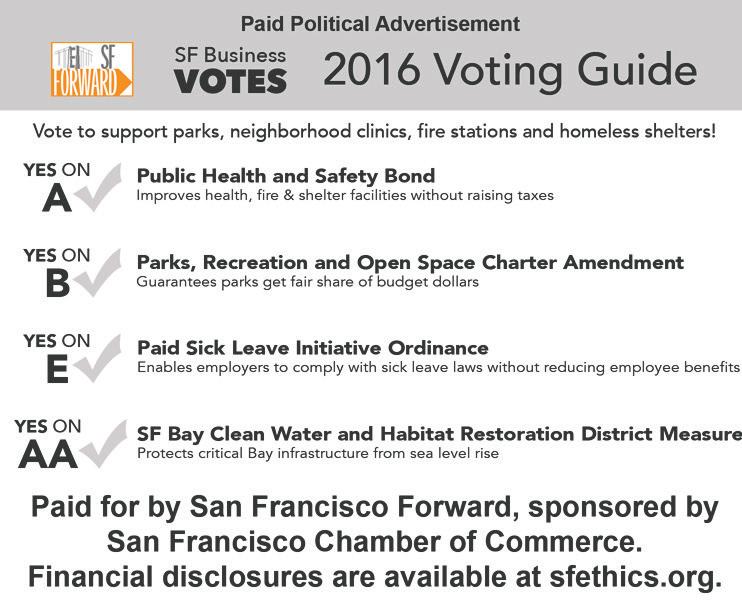
Homeless Outreach Team (SFHOT) or Mission Neighborhood Resource Center. By October 2015, 132 clients exited the center; most found stable housing or were sent home. Almost one-fifth of clients served by the Navigation Center – somewhat more than a quarter of all exits – left either voluntarily or by center request without being connected to housing. The Navigation Center generally asks clients to leave if they’re violent with staff or other clients, if substance use or personal behaviors pose a threat to community health, or if they cannot follow through with their housing plan.
Based on more recent information, according to Julie Leadbetter, 1950 Street Navigation Center's director, 26 people had been “evicted,” out of 470 people served, for breaking rules or because they weren’t suitable for housing, implying a significantly lower ejection percentage as the facility ramped-up.
As of September 2015, the Navigation Center had cost $1.7 million, excluding the significant expenses of City staff support and start-up costs of $700,000 to build the temporary facility. The average per bed per day cost of typical City-funded shelter services is approximately $36, but ranges between $15 and $63. In comparison, the Navigation Center’s average per bed per day cost is $69. While each shelter has its own approach, the Navigation Center model includes robust case management, which contributes to the higher cost.
“When we house the chronic homeless they are certainly healthier and their life prospects are better and it is also cheaper,” said Dodge, at the meeting. “It costs $17,000 to house someone in permanent supportive housing, but $80,000 when that same person stays on the streets…due to costs like emergency room visits” and other expenses. According to Dodge, traditional shelters provide a bridge
for people who are “transitionally” or “episodically” homeless. But the approach doesn’t work as well with the chronically homeless.
The 1950 Mission Street Navigation Center will close this year, and an affordable housing development constructed on the site. In the meantime, the City wants to build two other centers, one adjacent to Warm Water Cove; the other at the Civic Center Hotel, located at 12th and Market, which is slated for development within the next four years. No other sites are under active consideration.
The City wants to open the 24th Street Navigation Center on October 1, 2016, and operate it there for three years. The property would be leased from the Port Authority. Under Port rules, the site can only be used for non-maritime use activities temporarily. Dodge told meeting attendees that he’d be willing to put a ‘hard stop” into the lease with the Port to ensure that the Warm Water Cove facility is temporary.
According to a San Francisco Public Health staff person, the 24th Street Navigation Center would be a tranquil place, with no lines of people waiting, since clients are accepted by SFHOT referral. He noted that there was already an encampment at the site. Last month on a Sunday the area outside the 1950 Mission Street Navigation Center was clean and the sidewalks clear.
Department of Public Work’s Paul de Freitas explained that there’d continue to be pubic access through 24th Street and a “gateway” to the park with lighting. Security would be onsite, and the center would be built on a raised deck with as light a touch as possible. In addition, a public restroom would be installed, and trail improvements might be made to give better access to 25th Street.
“The 24th Street Navigation Center will be temporary,” said Dodge. “I want to build permanent housing, not permanent shelters.”
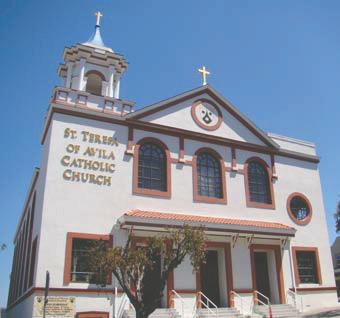

Wisconsin Street resident Margaret Keyes was born two months before the Great Depression engulfed the nation. Growing up in San Francisco’s Sunset District during those tough times, Keyes trained herself to become a keen observer of others starting at a young age. That salient skill spurred her into a long and fruitful career as a Jungian psychotherapist and writer. Inhabiting the home that she and her late husband, Vincent Keyes, purchased 45 years ago, Keyes reflected on her journey through the City’s changing character and what she’s learned from others along the way.
“It was a different world than this one. Potrero Hill was an artist’s district and there were many political radicals; not communists but strong socialists. The labor movement was powerful. Back then it was an easier life for working people,” Keyes said. “We used to have eye contact here on the Hill and in the City. Everybody kind of knew everybody. Now there isn’t quite that, but I know there are other things, like Facebook, that people are using now.”
Keyes had an active youth, growing up with two younger brothers, Frank and Jim Frings, in a City that felt like their playground. “We would go up to Nob Hill and swim in the Fairmont Hotel’s pool,” she reminisced. “We had horseback riding lessons in Golden Gate Park.”
Academically inclined, Keyes received a number of scholarships that allowed her to attend private schools, eventually graduating from the University of California, Berkeley. From there, she earned a master degree from Catholic University and a doctorate from the University of Chicago in psychiatric social work.
Back in San Francisco, Keyes received a fellowship to practice social work at Catholic Social Services, eventually serving as the agency’s director. She then worked as a clinical social worker at University of California Medical Center – now UC San Francisco – and was an adjunct professor at the University of San Francisco.
“I was always a watcher and a looker,” Keyes stated. “I’m particularly interested in groups, so it naturally led to my career choice.” Based on her many years facilitating group therapies in healthcare settings, Keyes believes that it’s in talking with one another that different ideas emerge about pos-
sible causes and treatments of diseases, as well as coping strategies for patients.
“Things just kind of click, as life itself is teaching us through shared experiences of living with illness,” she observed. “I think that one of the things that’s needed in medicine is more group process. Patients have a very inclusive frame of mind that doctors aren’t necessarily a part of. There’s a lot of knowledge that can come out of patients’ groups, as there is a collective perspective and experience.” Keyes believes that the therapist’s main role in such groups is to show participants how to listen and acknowledge their own strengths, helping them along in their journey.
For many years Keyes conducted an intensive type of individual therapy, which involved clients staying at her Muir Beach retreat center for weeks, spending time on the beach by themselves, writing, painting, and creating family narrative sculptures with clay. Men’s therapy groups were also held there, offering an outlet to talk in ways they couldn’t normally.
Keyes treasures the Potrero Hill home she shared with her husband, who worked as a real estate attorney. It was built in 1904, before the great fire of 1906, and contains parts of an old ship, such as a banister that had led up to the captain’s office. The home was once owned by an artist, who added mosaics into the woodwork. Keyes spends much of her time maintaining it and her Muir Beach property.
Keyes belonged to many writers’ groups over the years, energized by collaborations that created a collective feeling of being on the edge of something monumental. She’s authored several books about therapy and the enneagram personality classification system, including a light-hearted allegorical one entitled, The Enneagram Cats of Muir Beach. Though writing has been one of Keyes’ great loves, most of it was never intended for publication. “The art of writing is - in its essence - a maturing process for the writer,” she commented. “It just makes us much more conscious. It deepens all the forces that are around us and in our personal lives.”
Molly’s Daughter, A Three Generation Story Exploring: What do Women Really Want?, published by Arseya in 2008, is a fictionalized autobiographical work by Keyes that chronicles her

story through the character Lizby. Keyes wrote the novel in a colloquial style. She believes that it’s through everyday conversations that the most important life questions are posed, the grappling with which creates a greater understanding of the reality of existence. Arseya had pushed her for a hasty completion, but it was during multiple rewrites that Keyes obtained deep insights into her own greater reality as she solved the issues inside herself. “There are billions and billions of individuals and none of us are alike. We all have this absolutely unique reality. It’s fascinating. It takes us away from self-flattery because it can be anywhere; the human genius,” Keyes remarked.
Though she no longer conducts therapy sessions, Keyes is still very much an observer. The passage of time has honed the skill and provided an abundance of perspective from which she now views the world. “I’m really aware of how many critical things are in play right now,” Keyes stated. “This game mentality that has taken over the election process, where it’s like team sports, I’m concerned about that. There are a lot of things that concern me but I don’t want to judge it in terms of my own personal experience. We’re in an experimental phase that’s crackling with lots of different possibilities and I can be nervous but I’m not condemning and I’m not judging. It’s worth talking about. The more we push at it, the better the questions get.”
To Keyes, how to prompt people to consider the common good in their actions is a puzzle that involves everyone, as even the most basic interactions between two people influence the collective. She’s bothered by superficiality, though acknowledges that it’s always been a force in society. “We’re not always fully conscious all the time,” she admitted.
If circumstances had been different Keyes would’ve liked to have been a parent, and wishes there was more time to write. She feels that her life has been a valuable one largely by virtue of her affirming the skill of others.
Though there are many complex ways of looking at the collective, Keyes cites one simple one. “The only thing I really trust is to treat others as I would be treated. I think it is very important to appreciate.”
institutions from performing abortions, which prevents the next generation of medical professionals from learning how to do the procedure as aging doctors retire. In response, the number of abortion providers has drastically fallen. The chances of a clinic reopening or newly starting are small. Nationally, only 21 facilities have opened, while 162 have closed, since 2010.
Bloomberg News reports that just four percent of abortions are conducted in hospitals. These facilities don’t want to tread in politically charged waters, and local governments and religious institutions running hospitals frequently prohibit offering abortions. Likewise, according to Bloomberg News, at least a dozen abortion clinics closed in California since 2011, most of them in the Bay Area. Given that the state has few legal restrictions on abortions, the high number of closures suggests the financial burdens associated with operating a clinic.
San Francisco clinics that offer abortion services or referrals, as well as information about options available to women seeking help during a pregnancy, are Planned Parenthood, the University of California's San Francisco Women’s Options Center, San Francisco General Hospital’s (USFGH) Women’s Options Center, and the Women’s Community Center (WCC), at 1833 Fillmore Street.
Planned Parenthood has several Bay Area clinics, and is known for its acceptance of whichever path its clients choose. A woman is counseled alone if she comes in with a partner, giving her privacy to convey whatever information she wants to, including disclosing if there’s any pressure to have an abortion.
According to a 2015 Christian Science Monitor article, clients found Planned Parenthood staff to be “nonjudgmental,” and helpful. The Planned Parenthood facility on Valencia Street offers abortion services, birth control options, HIV testing and services, LGBT services – such as hormone therapy – Morning-After Pill emergency contraception, pregnancy testing and services, and sexually transmitted disease testing, treatment and vaccines. It accepts insurance from Anthem Blue Cross Blue Shield of California, Contra Costa Health Plan, Partnership Health Plan of California, as well as Obamacare, but provides services to whomever needs

Dawn Porter, who lives on the 300 block of Missouri Street, has directed several award-winning, social justice documentaries. Gideon’s Army (2013, HBO) recounts the personal stories of three young lawyers, who, as part of the Southern Public Defender Training Center – now known as Gideon’s Promise – help make "justice for all" a reality while working to revolutionize the way Americans thinks about indigent defense.
Spies of Mississippi (2014, PBS) investigates the Mississippi State Sovereignty Commission (MSSC), a secret spy agency formed by the state of Mississippi to preserve segregation and maintain white supremacy during the 1950s and 1960s. Rise: The Promise of My Brother’s Keeper (2015, Discovery) follows programs in Chicago, Baltimore, and California that’re working to answer President Obama's My Brother's Keeper challenge, striving to help boys and young men of color reach their full potential.
Porter’s most recent film, Trapped, won a Special Jury Award for Social Impact Filmmaking at its Sundance Film Festival world premiere earlier this year. Trapped focuses on the Supreme Court case Whole Woman’s Health versus Hellerstedt (formerly Cole). The case stems from a challenge to a Texas law, House Bill 2, which caused more than half of the abortion clinics in Texas to close. These Targeted Regulations of Abortion Providers, referred to as "TRAP" laws
by reproductive rights advocates, effectively limit access to abortion services, especially for women living at, or under, the poverty line, who are frequently of color.
According to the film’s press release, "TRAP laws masquerade as regulations designed to protect women’s health, but in fact have a singular purpose: to ban abortion by saddling clinics with onerous regulations that are exceedingly difficult and costly to satisfy. Trapped follows the plaintiff and legal team leading the case, as well as the struggles of the clinic workers and lawyers fighting to keep abortion safe and legal for millions of American women…"

so many things that had never before crossed my mind. I learned about the hundreds of regulations in effect across America that restrict access to abortion services."
them, whether or not they’re insured, offering a sliding pay scale based on income.
WCC is a nonprofit that operates on a volunteer-based business model. After the Women’s Needs Center of the Haight/Ashbury Free Clinics Inc. closed in 1999, a group of medical professionals and community members collaborated to open WCC a few months later. The center serves any female-identified or female-bodied individual 12 years of age and older who wants health care services, including sexually transmitted illness screening and treatment, birth control, prenatal care, acupuncture, and colposcopy. While it doesn’t perform abortions on site, it provides referrals for abortion services, as well as ultrasounds, alcohol and substance abuse treatment, and mental health services.
Porter was in Jackson, Mississippi shooting a film in 2013 when she noticed an article in the local newspaper about the last abortion clinic in the state. "I could not believe I was reading the article correctly; could there really be just one abortion clinic left in the entire state? I called the clinic and asked if I could come over and meet its director. Until that day, I had never been in an abortion clinic, not even to accompany friends who had the procedure."
Porter was anxious and afraid as she made her way through a knot of protestors in front of the clinic to meet with Dr. Willie Parker and the Jackson Women's Health Clinic staff and clients. "I felt ashamed at all the things I learned during our meeting;

Trapped follows the providers –male and female, black and white – who powerfully express their passionate commitment to ensuring abortion access to women, and poignantly explain their predicaments. The maps, statistics, and other information shown in the documentary provide easily accessible context, exposing an important story that many Americans may not be aware of.
"Over the course of making this film I witnessed what I truly believe is not only a threat to abortion access, but also a threat to our democratic ideals,” said Porter. “States passing laws that flagrantly disregard the constitutional protections set forth in Roe v. Wade are not just a challenge to abortion access, they are a challenge to the rules of our democracy. While I’ve seen things that are frightening, like harassment and threats, I’ve also seen what real courage looks like. Despite this incredibly hostile environment, doctors and support staff at abortion clinics across America are refusing to give up. Their determination and resilience are what inspired me to create this film."
Trapped will be broadcast on PBS in June 20.
The UCSF Medical Center, which manages the Women’s Options Center, is ranked eighth on the U.S. and World News Report Best Hospitals list for 2015-2016; its gynecology department is rated sixth. Operating from 2356 Sutter Street, the center offers abortions, counseling resources, and referrals to other clinics and providers, including WCC. UCSF trains medical professionals in family planning, while conducting clinical research on abortion and contraception. Out-of-pocket prices for women without insurance is $725 for a first trimester abortion, and about $800 for a second trimester abortion.
The Women’s Options Center at USFGH accepts Medi-Cal, and offers an out of pocket price of about $400 for a first trimester abortion.
The abortion pill, or a medical abortion, accounts for 20 percent of abortions nationally. However, according to a Guttmacher Institute study released earlier this year, medical abortions are strictly regulated, with 37 states requiring the clinician performing the procedure to be a certified physician and 17 states mandating that the clinician be physically present during the procedure.




The public is invited to celebrate the opening of the 58th Annual Potrero Hill Artists’ Exhibition on Saturday, May 7, from 6:30 to 9 p.m. at the Potrero Branch Library, 1616 20th Street. Festivities will include live jazz by Clifford Brown III, with refreshments provided by Hill merchants.
The 2016 exhibit includes 70 artists who live, work, or study on the Hill, showing work that ranges from painting
and photography to ceramics, sculpture, and multi-media. The exhibition is San Francisco’s oldest annual art show. In 1951, the late artist Charles Farr gathered a group of individuals who painted with or were tutored by him to stage an exhibit in order to save the Potrero Branch Library from threatened closure for lack of funds. Proceeds from the sale of artwork from that show kept the library open.
The exhibit will run during library hours from May 7 to July 28.

commercial street, as well as to the Pennsylvania Street Caltrain station and T-Line, but it was previously uncared for. The alley is an ‘unaccepted’ street, meaning it’s not maintained by the City. Nearby residents and businesses collaborated with the Dogpatch Neighborhood Association and successfully secured a Community Challenge Grant for the beautification project. The alley includes a glow-in-the-dark retaining wall, palm trees, succulents, benches and water fountain. All materials are recycled; lights are solar powered. Angel Alley’s upkeep will be funded by the Green Benefit District , which collects a special ‘property tax’ like fee to help pay for maintenance of community-led greening projects. “Angel Alley preserves the original flavor of the area,” said Park steward Kristin Swanson . “As Dogpatch develops and the neighborhood's needs evolve, it was essential to beautify this pedestrian pathway to 22nd Street.”
The San Francisco Recreation and Park Department broke ground on a new park locating on a former parking lot at 17th and Folsom streets in March. The $5.2 million
May 5 through 29
Theater: The Most Dangerous Highway; Tells an Afghan Boy’s Tale of Resilience
The play follows a fearless eightyear old businessman, who calls himself "Traffic" and makes his living directing traffic on the treacherous highway connecting Jalalabad to Kabul. Soldiers, accidents, and ghosts are no match for this little fighter who has a knack for surviving the toughest challenges. Inspired by a New York Times article about the real-life “Pepsi bottle boys” of Afghanistan. Tickets: $10 to $34. Thursdays through Saturdays at 8 p.m., Sundays at 3 p.m. Opening night is May 9 at 8 p.m. The Thick House, 1695 18th Street. Information: goldenthread.org.
Art: Jessie Bunn
Opening for local artist Jessie Bunn, with waterfront drawings, 6 to 9 p.m.. Farley’s, 1315 18th Street.
micro-short videos explore the intersections of identity, culture, and stigma for A&PIs living with or affected by HIV. Presented with compassion, this film series honors the hope, strength, and resiliency of A&PI communities on National A&PI HIV/AIDS Awareness Day. Free with museum admission. 7 to 8:30 p.m. at Samsung Hall at the Asian Art Museum, 200 Larkin Street. Information: asianart.org/ events.
May 20 and 21
Art: Recology Residence Exhibitions
project, principally funded by a $2.7 million California Recreation and Parks Department Statewide Park and Community Revitalization Grant, will create a 31,850 square foot neighborhood park – about the size of a medium-sized grocery store – that’ll feature an outdoor performance and classroom space, lawn, children’s play area with interactive water feature – with the water recycled for subsurface irrigation –adult fitness equipment, community garden, native landscaping/drought tolerant shrubs and trees, wildlife habitat and educational gardens, and accessible pathways and lighting. It’s the delightful reverse of “paved paradise and put up a parking lot,” woo-woo-woo-woo.
The Untitled art fair, which has been held in Miami Beach during Art Basel since 2012, is expanding to San Francisco. The inaugural edition of Untitled San Francisco will open January 2017 at Pier 70. Upwards of 60 galleries are expected to participate, less than half as many art vendors as appear at Untitled Miami Beach . Pier 70 is being redeveloped by Forest City Enterprises , a $10 billion real estate investment firm based in Cleveland, Ohio. Untitled is part of a wave of art activities
Craft: Locket Box Necklances
Just in time for Mother's Day, create a one-of-a-kind necklace with a secret surprise inside! Decorate the outside with paper, fabric, lace or other materials, slip a special note, poem or picture inside, or construct a tiny diorama. $10 non-member child, $5 member child. 1:30 to 3:30 p.m., Museum of Craft and Design, 2569 Third Street. Information: 415.773.0303.
Film: Without Shame: Stories about HIV from the Community A screening of powerful, personal stories created by Asian and Pacific Islander filmmakers. These
flowing Southside, including Altman Siegel , a prestigious gallery for conceptual art and large-scale painting. In August, owner Claudia Altman-Siegel will move from her 1,900-square-foot space on 49 Geary Street to 5,000 square feet in the Minnesota Street Project , a threebuilding arts cluster. “I have a young gallery, but I always have this dream and vision of having a big gallery,” said Altman-Siegel. “This is the perfect space for that kind of thing.” Formerly a parking garage for an electric company, 1150 25th Street is about half the size and a short block from the project’s cornerstone building, 1275 Minnesota Street, which opened in March, attracting 6,000 visitors on its first weekend to 13 galleries. The 25th Street structure will be divided into three galleries, each with 40-foot ceilings and multiple skylights. “There is so much natural light and so much huge dimension that it is easy to imagine doing super-ambitious art projects here,” said Altman-Siegel, who arrived seven years ago from New York, where she’d been the senior director of Luhring Augustine, a blue-chip Chelsea gallery dealing in contemporary art.
The California Department of
The Artist in Residence Program at Recology San Francisco will host an exhibition and reception for artistsin-residence Kate Rhoades, Weston Teruya and student artist Cristina Velázquez. This exhibition is the culmination of four months of work by the artists, who have scavenged materials from the dump to make art and promote recycling and reuse. Friday, May 20, from 5 to 9 p.m. and Saturday, May 21, from 1 to 3 p.m. Additional viewing hours will be held on Tuesday, May 24, from 5 to 7 p.m., with a gallery walkthrough with the artists at 6 p.m.
Art: Constructed Communication Curator Walk-Through
Picking up threads of the handmade in our impersonal digital era, Kenji Nakayama, Amy Sinbondit and Ben Venom utilize traditional craft techniques to construct objects that communicate in nontraditional ways: through symbols, typography and gestures. Learn more about their craft. 6:30 to 8:30 p.m. Museum of Craft and Design, 2569 Third Street.
Alcoholic Beverage Control (ABC) is recommending approval of the Third Street Taco Bell’s liquor license, if proposed conditions are met, including limiting sales and service of alcohol to between 11 a.m. and 10 p.m. Sunday through Thursday, going to 11 p.m. on Friday and Saturday. The restaurant would be prohibited from selling and serving alcohol through the pass-through window and vending alcohol for consumption off-premises. It’d be required to limit noise, clear trash around its premises, prevent loitering, and post signs at conspicuous points at entrances and exits declaring that alcoholic beverages are prohibited beyond those positions. ABC will hold an administrative hearing to hear any concerns about its recommendation on May 25, 9:30 a.m., Milton Marks Conference Center, 455 Golden Gate Avenue, Lower Level, Benicia Room.
It should have been “PlayGround” in the headline and throughout the article in “Playground Takes Over Thick House,” in the March issue, and contrary to what’s implied in the story, Jim Kleinmann left the Berkeley Symphony in 2011…And the name is “Mirkarimi,” rather than the misspelled moniker in last month’s April Fool’s issue.
SHORT CUTS from page 2Festival: How Weird Street Faire
How Weird Street Faire is a menagerie of attractions, including a world-renowned music festival featuring 10 stages with different styles of dance music, an open air art festival filling an expanded Art Alley, a unique market of interesting vendors and delicious food, and a platform for performers of every type. People in colorful costumes from around the world will celebrate diversity, multiculturism, and peace. This year's theme is "The Cosmic Stew", a fusion of individual perspectives on different ways of living. The Faire celebrates acceptance, demonstrating that differences can be a good thing, and being weird is wonderful. It’s a weird, weird world that’s becoming more connected every day. Noon to 8 p.m. Howard and Second streets. $20 for a Magic Sticker at the faire. Information: howweird.org.
Community Meeting:
2130 Third Street:
Child, Teen and Family Center
The University of California, San Francisco will hold a meeting to discuss development of a Child, Teen and Family Center at 2130 Third Street, along 18th Street between Third and Tennessee streets. Help plan this facility, which’ll provide a state-of-the-art setting for
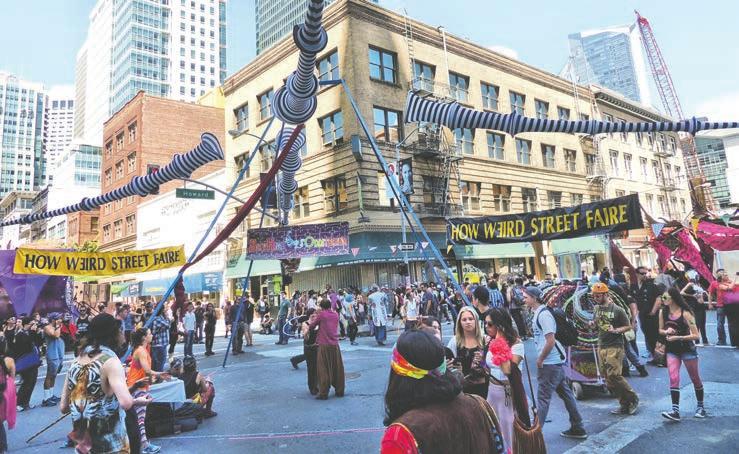
family-focused mental health care, informed by the latest research in psychiatry and neuroscience. UCSF will share information about its process for designing and building the center, which’ll offer services to the broader Bay Area while improving understanding of illness prevention and treatment of children, adolescents and adults. 6:30 p.m., Minnesota Street Project Art Gallery, 1275 Minnesota Street. Information: 415.476.3206.
Health: Center of Excellence in Health Street Fair

UCSF National Center of Excellence in Women’s Health celebrates its 20th anniversary with a street fair that’ll feature activities for children, such as face painting, clowns, and balloon artists; live entertainment, including “SF Slam Master” poet Mona Web and all-female salsa jazz band Azúcar Con Aché; and yoga, basketball, Zumba, and Tai Chi activities. Healthy sandwiches, snacks, and desserts, including authentic Mexican and traditional Jamaican food, will be for sale. Free. 10 a.m. to 3 p.m., 2356 Sutter Street. Information: 415.353.7481
Community: Exploring Hunters View
In honor of Bike Month, the San Francisco Housing Action Coalition will host a ride through Bayview to explore the new community at Hunters View. Built in 1956, the 256-unit public housing project provided workforce housing during World War II; it was never intended to be permanent. Over time, the development became virtually uninhabitable. The City and County of San Francisco launched a revitalization effort in 2005, which has created an almost 800-unit, mixed-income complex with on-site relocation for existing residents. This will be a roughly two hour tour, including 30 minutes of slow pace biking to/from Hunters View. Your bike must be in good condition and you should be comfortable biking on hills and urban streets. Meeting location will be announced upon registration. Free for SFHAC members. Non-members: $10. Registration and Information: http://www.sfhac.org/event/ bike-ride-to-hunters-view/
Music: Daniel Berkman
Live music by Potrero Hill resident Daniel Berkman, a composer, multiinstrumentalist and innovator of the kora, a 21-stringed harp/lute from West Africa. 7:30 to 9 p.m. Farley’s, 1315 18th Street.
May 11th and May 25th
Community: Green Benefit District
Dogpatch & Northwest Potrero Hill Green Benefit District general board meeting to discuss how to green, clean, and beautify public spaces. Free. 6:30 to 8 p.m. Tivoli Room, UCSF, 654 Minnesota Street. Information: www.dnwph-gbd.org.
Community: Starr King
Open Space Annual Meeting and Election
The meeting will include a special presentation on the status of the Coral Road removal project. If you’re a Potrero Hill resident and would like to help preserve neighborhood grassland, consider running for one of the three open seats on the board. Apply online. All residents, renters and homeowners, 18 and older are eligible to run, as well as vote for candidates at the meeting. Doors open a half-hour early for an informal meet and greet with candidates. Pizza donated by Goat Hill Pizza. 6:30 to 7:30 p.m. Starr King Elementary School, enter via Wisconsin Gate. More information: starrkingopenspace. org.
Beer: Brewery Shuttle
The San Francisco Brewers Guild, composed of 26 breweries, has created the City’s first free, hop-on/hop-off “Drink SF Beer Shuttle,” showcasing neighborhood breweries. The fun kicks off with a “Meet the Brewers” event at 6 p.m., typically featuring special release beers. Shuttles operate every 20 minutes from 7 to 11:35 p.m. on the third Wednesday of the month, moving to a different neighborhood each time. May event: Dogpatch/Mission Bay Line: Harmonic Brewing > Magnolia Brewing at Smokestack > Triple Voodoo Brewery > Anchor Brewing at The Yard > Speakeasy Ales & Lager. Information: sfbrewersguild.org.
Family: Bowl-thePlanet Party and Silent Auction
This event raises funds to support scholarships for schools serving low-income families to receive award-winning, hands-on environmental education programs and for critical conservation projects in threatened rainforests, coral reefs and desert ecosystems. For every $100 raised two acres of rainforest are saved or an Insect Discovery Lab or Edible EdVentures class scholarship provided. Registration, $35/ adult and $15/child. 5 to 8 p.m. Classic Bowling Center, 900 King Drive, Daly City. Information and registration: bowltheplanet.org.
Two San Francisco moms, Debbie Findling and Abby Porth, who both experienced fertility losses, co-created a project to develop a “memory garden” that'll provide a place for reflection and mourning of an inability to conceive ,or are mourning miscarriages, and stillbirths.
The Jewish Community Memory Garden will be located on the grounds of Sinai Memorial Chapel’s Eternal Home Cemetery in Colma, and be open to all faiths. The two women, who developed the idea for the garden in 2009, also hope to spur the creation of educational materials for social workers, chaplains, doctors, and nurses about Jewish views on infertility and fertility loss.
According to Sam Salkin, Sinai Memorial Chapel’s executive director, the final design and budget for the Memory Garden will be completed this month. Construction is expected to begin late this year or early next. “When the concept paper was brought before Sinai’s board of directors, everyone was very positive, very animated,” said Salkin. “They immediately stood up and said, ‘Let’s do this.’” Sinai’s board unanimously voted to donate land for the Memory Garden. In addition, each board member has made a financial contribution to the project.
“People who have had these losses
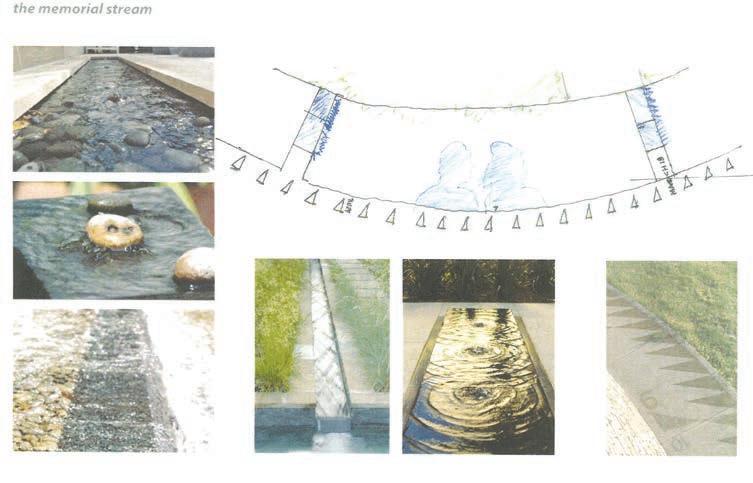
have suffered alone,” said Salkin. “They may not even have talked to their best friend about it. The Memory Garden is a way to take a conversation that’s not quite underground, but terribly muted and limited, to the community. With the Garden, we’re essentially putting our arms around the shoulders of those who have experienced a loss and saying, ‘We’re here for you.’”
According to Salkin, the Garden will be quiet, with little nearby vehicle traffic. At its core there’ll be a 55 feet diameter circular water element. A rock covering will enable visitors to pick up stones and place them in a water trough, in accordance with the Jewish tradition of placing stones on or near a grave. Placement of the pebbles
will subtly change the sound of the running water.
The Garden will have a meditative area encircled by redwood trees, small when planted, but eventually big enough to form a canopy. There’ll be a number of places for individuals or couples to sit, with a mini-amphitheater for gatherings. California native plants that don’t require much maintenance will populate the grounds. Similar to the AIDS Memorial Grove, there’ll be no graves in the Garden.
Over the past couple of years, Sinai has held two focus groups about the project. The first was composed of individuals who had experienced
GARDEN page 21
“Have you heard of Henrietta Lacks?” Stephanie was slumped in the bean bag chair, staring at the ceiling. The fog from Nash, Justin, and Jordan’s marijuana exhalations was fading as the trio’s huffing at the vaporized herb slowed, and then stopped. “And what up with the popcorn ceiling? I hate that!”
“Popcorn, yeah, that’d be good,” exclaimed Jordan.
“With Land o’ Lakes butter on it. Good call, Stephanie,” said Nash.
Stephanie sighed. “Lacks, not Lakes. Henrietta Lacks. She was a Black woman. In the 1950s she got cervical cancer, and died. But the cells from her tumor were used for medical research. HeLa cells.”
“HeLa. That’s cool,” said Justin. “Kind of a drag queen name, or a song chorus.”
“A helala, a helala, ahelala, awaaay,” sang Jordan.
“Shut. Up,” said Stephanie, struggled on the bean bag chair to sit up. “I’m going to tell you this once. Then, no doubt, you’ll forget about it, and we’ll talk about getting the dot and putting it in the Mayor’s Office.”
Seeing Jordan slap a hand over his mouth, Justin covered his ears.
GOLD page 26



What would life be like without partners? At Sutter Health’s St. Luke’s campus, our caregivers listen to you, like the specialists at St. Luke’s comprehensive Women and Children’s Center. Plus, we provide tools that connect you – like email messaging, online medical records, prescription refills and same-day appointments. And, whenever you need to visit, we’re nearby with eighteen physician offices and four CPMC hospital campuses, including St. Luke’s. Because local partners help make life a little easier. It’s just another way we plus you.


On January 1, 2016, The California Comprehensive Sexual Health and HIV/ AIDS Prevention Act went into effect. The Act is intended to equip students with information to protect their reproductive health, and foster healthy attitudes about puberty, sex, gender, and relationships. The law mandates that HIV/AIDS prevention be taught at least once in middle and once during high school, and that comprehensive sexual health education conform to certain standards, which excludes abstinence-only teachings. The law sparked controversy in some counties, but San Francisco schools have generally conformed to the new requirements without difficulty.
Though the legislation only affects public schools, many private institutions, such as Live Oak School, located on Mariposa Street, have long histories of providing sex education curriculums and fostering open dialogue about sex. Nate Lundy, Dean of Student Life at Live Oak, emphasized the importance of adjusting curriculum in response to changing cultural realities. “We provide an adolescent health curriculum taught by a trained Planned Parenthood professional,” Lundy said. “She caters the conversation to anything the kids want to discuss, and recently remarked that the current sixth grade class is the most advanced ever in terms of being able to have a mature discussion. It’s absolutely necessary, and we wouldn’t ever think of backing off of it. The curriculum is currently offered for fourth through eighth
grades in an age appropriate manner. For the fourth through sixth grades especially, we cover things like anatomy, peer pressure, social media pressures, gender roles, and healthy relationships.”
Lundy admitted that the school’s sex education program, which has been offered for the past nine years, differs greatly from lessons parents of current students received when they were young. He cited proactive communication as essential to dispel parental fears about what’s being discussed in classrooms. Before lessons are given, teachers and school staff have conversations with parents about what exactly will be taught, providing an opportunity to ask questions or voice concerns. Parents are encouraged to initiate their own dialogues with their kids.
“We cover all issues of sex, gender and sexual orientation,” Lundy clarified. “We made adjustments to our curriculum this year. In addressing fluidity and also to help girls and boys learn from each other, we no longer separate them during the sex ed classes. It helps take the mystery and discomfort of talking about it away. We just started having discussions about gender identity. We’ve added gender neutral bathrooms and have started relevant discussions at an age appropriate level.”
The San Francisco Unified School District has been ahead of the new legislation, providing a high school curriculum that meets the Act’s requirements even before it was enacted. Other school districts, such as Oakland and Marin, asked SFUSD for assistance, and
incorporated some of the lessons developed in the City into their materials.
According to Christopher Pepper, a former health education teacher at Balboa High School and the District’s Young Men’s Health Project Coordinator, the California law prompted SFUSD to make sex education more consistent at the middle school level. “About five percent of our middle school students have reported that they are sexually active. We want pregnancy and STI prevention for these students,” Pepper stated. “It’s been hard to fit the sex education lessons into the greater health curriculum for the middle school level because it’s taught throughout various subjects at different times. It hasn’t been consistent so far, but we’re working on improving it.”
Be Real, Be Ready is the sex education curriculum taught at SFUSD high schools. The class is required for graduation, and was developed three years ago by San Francisco Department of Public Health staff, school district teachers, and the Adolescent Health Working Group. Community-based organizations – such as Mission Neighborhood Health Center, Huckleberry Youth Programs, and Planned Parenthood – assisted with curriculum development. In addition to teaching about HIV, sexually transmitted diseases, and pregnancy prevention, the class covers issues around sexual consent, and is being expanded to address sex trafficking.
In February, the San Francisco Board of Education approved a policy to require middle schools to make
condoms available to their students beginning this fall, in addition to the current condom distribution program at the high school level. “There were some parents who expressed concern about the condom availability program,” said Kevin Gogin, SFUSD Director of Safety and Wellness. “The students have to dialogue with someone; even in high school there’s always an adult present. Students have to talk with a nurse or educator before accessing condoms. Knowing this alleviated some concern for many parents. We always encourage students to talk to their families and try to facilitate some of those conversations. We hope that parents can reinforce talking openly about these topics at home.”
Live Oak School doesn’t distribute condoms. “We teach the safe use of condoms and how to put them on. We leave it to parents to get sexual health care and condoms for their kids,” Lundy remarked.
Burton Academic School, O’Connell, Mission, and Balboa high schools have wellness centers that’re staffed with nurses and health educators who provide support around complex issues, such as depression, bullying, substance use, and sexual health. Students can access free condoms at these centers. Willie Brown Jr Middle School, which recently opened in Bayview, is the City’s first middle school to have a wellness center.
Because the wellness centers don’t provide more sophisticated levels of care, such as sexually transmitted
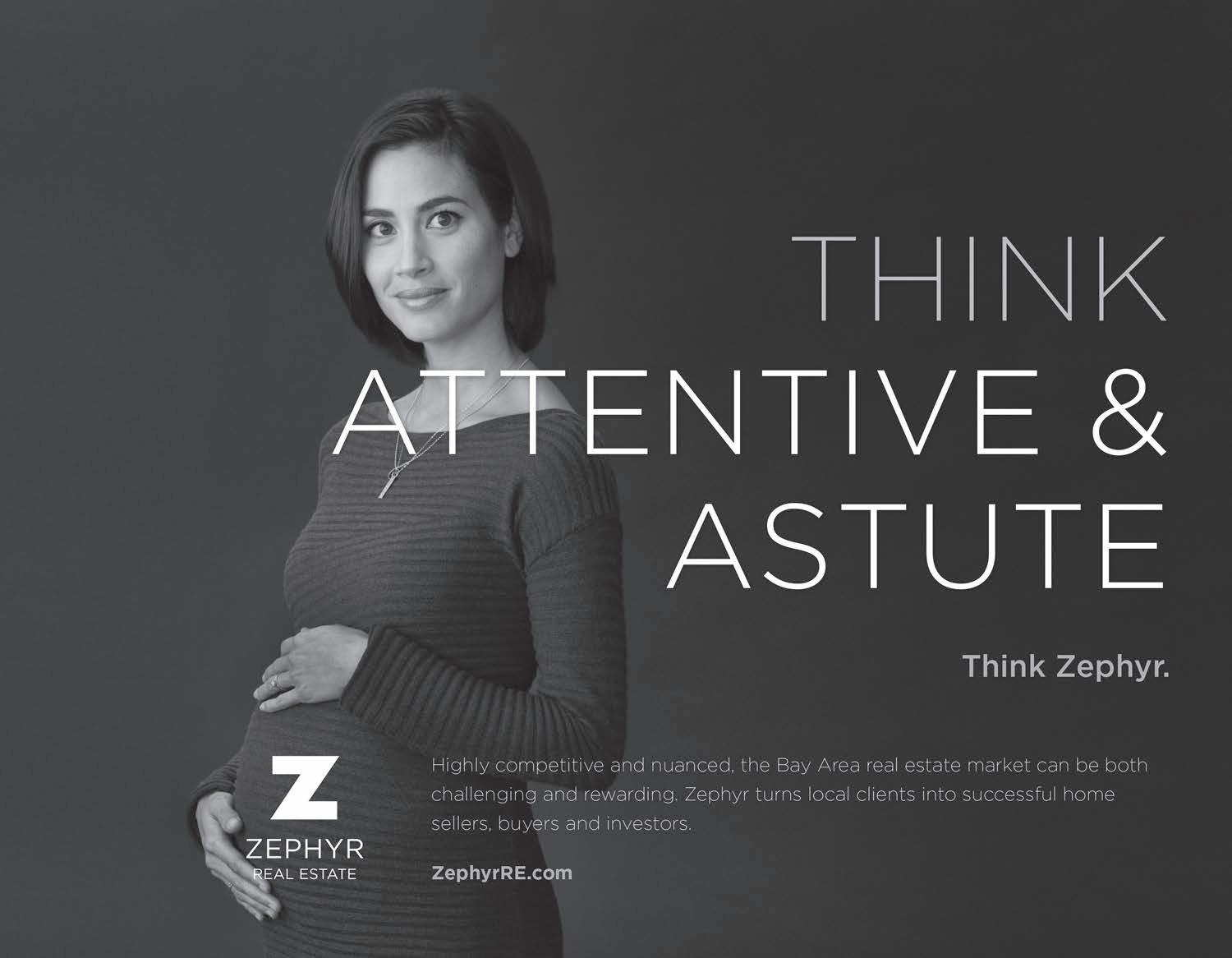
According to Joi Jackson-Morgan, when 3rd Street Youth Center clients discovered the health risks associated with beauty products by looking at the Environmental Working Group’s SkinDeep Cosmetics Database, they were shocked. Bayview-based 3rd Street—which provides health services, fitness, cooking and art classes, among other programming, to 12 to 24 yearolds—decided to introduce the SkinDeep database to the its Youth Action Board following publication of a University of California, Berkeley study showing that levels of four potentially hormonedisrupting chemicals were reduced in the systems of 100 girls who stopped using certain cosmetics.
The SkinDeep database offers numerical ratings of cosmetics based on their ingredients’ safety, one being safest and 10 being least safe. “Beyonce’s ‘Heat’ had a 10. Rihanna’s, I think hers was like a nine, and that’s what is marketed toward them,” said JacksonMorgan, 3rd Street’s deputy director. Rihanna's "Reb'l fleur" actually scores a 10 on SkinDeep.
Jackson-Morgan was referring to perfumes that contain an ambiguous ingredient on their labels called “fragrance,” defined by EWG as “an undisclosed mixture of various scent chemicals and ingredients used as fragrance dispersants, such as diethyl phthalate. Fragrance mixes have been associated with allergies, dermatitis, respiratory distress and potential effects on the reproductive system.” The Food and Drug Administration, which regulates cosmetics, doesn’t require companies to disclose what makes up an ingredient identified as "fragrance."
The UC Berkeley study, conducted in conjunction with Clinica de Salud del Valle de Salinas, and released in March, found that when the teens stopped using products that contained four chemicals—phthalates, parabens,
triclosan, and oxybenzone (BP-3)—the presence of those substances in their bodies decreased by 27 to 45 percent.
Phthalates are often found as part of that 'fragrance' ingredient listed on perfumes and nail polish. “Phthalates are a great example because they have this property where they can interfere with the production of testosterone," said Dr. Tracey Woodruff, director of the Program on Reproductive Health and the Environment and a professor of Obstetrics, Gynecology, and Reproductive Sciences at the University of California, San Francisco. "Exposure to phthalates can lead to reduced testosterone levels. That's been shown in the animal studies."
Reduced testosterone levels, Woodruff explained, can lead to a host of health problems. "Lots of these hormones are important because they orchestrate different parts of development,” she said. “During the prenatal period, for example, you get this surge in testosterone because that's what makes the male reproductive developmental form…So if you don't have enough testosterone, you basically don't get complete formation of the male reproductive tract."
According to Woodruff, studies show that another of the chemicals, triclosan, can impede thyroid hormone levels. A decrease in thyroid hormone levels has been shown to affect brain development during the prenatal period; one study has linked a reduction in thyroid hormones in mothers to a lower IQ in offspring. Woodruff said there are fewer reports on parabens and oxybenzone, but culture dish studies suggest that they could interfere with estrogen production.
According to Ynessa Flores, who attends 3rd Street’s weekly seminar for young mothers called Young Moms, the risk of exposure to potentially harmful chemicals is news to her. "I didn't know that,” she said. “And it's kind of worrying, because sometimes I let my

daughter play with [my makeup] Yeah, I think they should [be required to label cosmetics with this information.] Even stuff as simple as when they test it on animals and stuff. I see that on bottles, and I guess that's something I kind of look for, but especially for hormonal stuff."
Jackson-Morgan said that after getting such a positive reaction from the Youth Action Board, 3rd Street will likely demonstrate the SkinDeep database to other youth groups. The database can be accessed through EWG’s mobile application, which is available for iPhones and Androids, in addition to its online site..
3rd Street is one of a handful of health centers geared specifically toward Southside youth. Others include the Balboa Teen Health Center in Balboa Park, the wellness center at Phillip and Sala Burton Academic High School in Portola, Hawkins Village Teen Health Center in Visitacion Valley, Hip Hop to Health Clinic in Ocean View and UCSF’s New Generation Health Center, also known as “NewGen,” NewGen will close this summer due to “financial unsustainability,” according to a UCSF statement.
“As New Generation closes, the network of youth-serving clinics in the Department of Public Health and its
COSMETICS page 23
illness testing and treatment, schools have historically referred students to the New Generation Health Center, a free-standing young adult clinic run by the University of California, San Francisco. The clinic, founded 20 years ago, will close its doors this summer. DPH is forming a working group to develop plans to ensure the continuation of services for youth through other City clinics.
“There are a lot of youth clinics in the City, what’s unique about New Gen is that it’s free standing. They’re not going to run into their aunt or other adults at the clinic,” said Rebecca Jackson, MD, Chief of Service for OB-GYN at Zuckerberg San Francisco General Hospital. “This is a really treasured resource for youth.”
Outreach work that New Generation Health Center provided high schools will be taken over by DPH. Youth who access care at the center will be referred to other clinics that have capacity.
Jackson, technically an UCSF employee, has received numerous letters from schools and community members thanking her for New Gen’s outreach efforts. Though she feels the center’s closing will be a loss to City youth, she's hopeful about the new legislation. “It’s fantastic,” she said. “I feel like our country in general is behind in its ability to talk about sex, but this is especially true with kids. In Europe, sex is considered a normal part of life and is openly talked about. They also openly talk and teach about parenting. which is very related to this.”


The MRC Rebels Girls Basketball Club was founded in 1988 by Oscar Jimenez, who saw a lack of basketball opportunities for San Francisco girls and sought the City’s help to fill the gap. The program received City funding early on, though Jimenez paid for some expenses out of his own pocket. When Jimenez died suddenly in 2010 at the age of 57, many of his youthful club members lost a mentor and father-figure. Slowly, with the help of new talent, the club has successfully rebounded.
“It’s unique because of its legacy and affordability,” said assistant coach, Mark Reppert. “We have girls coming up from South City largely due to the legacy created by Oscar. The team is made up of girls from an array of backgrounds and cultures, which I think is rare for San Francisco these days. This diversity represents what the Mission is at its heart.”
The club is based at the Mission Recreation Center, 2450 Harrison Street, and offers year-round basketball training by skilled coaches and teachers for girls from third grade through high school. It’s the Bay Area’s oldest member of the Amateur Athletic Union (AUU), with funding from the San Francisco Recreation and Parks Department. Parents of players who want to compete in AUU tournaments pay $450 per season, unless they qualify for a scholarship. About 20 percent of players get financial assistance from the City to play.
Wilson Stevens, MRC’s director, joined the program two years ago as a coach after an eight year professional basketball career in Europe. Stevens is originally from San Francisco, attended Everett Middle School and started playing basketball as a youth. According to Stevens, it took dedication to recover from Jimenez’s death. “We have a very different group of coaches and they’re all phenomenal,” Stevens said. “My first coaching
experience was at MRC, and it was an adjustment to start coaching younger players. Patience has helped me become a good coach and having my three year old son has helped me become patient. Our program is different because we don’t turn anyone away. We try to get inner city girls off the street and provide them with basketball experience. The ultimate goal is to get the girls a college scholarship. Even if they don’t get a scholarship, the program provides them with a chance to develop themselves and their skills.” At least 67 MRC players have gone on to play at the college level, including at Pepperdine, University of California, Berkeley, Princeton, Stanford, and Duke.
Head coach, Rod Hodges, has a 14 year history with MRC, witnessing its evolution. “Oscar was a big influence on my coaching as well as on a lot of the girls in the community,” Hodges commented. “He took everybody in. A lot of the girls had no other outlets other than basketball. He was able to get coaches who were busy to donate their time. Coaches saw him giving back to the community and wanted to join his effort. Wilson is doing that now. Wilson is a lot like Oscar and has brought back the vision that was lost after Oscar passed away.”
City funding is integral to MRC’s success. As the only AUU basketball program in San Francisco that receives municipal money, scholarships are offered to residents on an as-needed basis. This support enables the program to welcome girls regardless of their skill level. However, the program could use more help. “The City only funds the high school team. If we had more sponsorships we could afford uniforms and equipment for the younger girls,” Stevens said. “Some of the parents can’t afford to travel to the farther games, so the sponsorships could help parents get to their kids’ games. Those who make donations to the City can get their money earmarked to the MRC and receive a tax deduction.”

The club raises money by operating a concession stand during games, which helps support expenses not covered by municipal funds. “When girls on trips can’t afford to buy meals on the road, Wilson makes sure everybody has three meals a day,” Hodges remarked. “When we were in Chicago, he made sure there was time for girls to experience the city. He’s making it about the girls. He doesn’t care if they have money or not. If a girl wants to play that’s all that matters.”
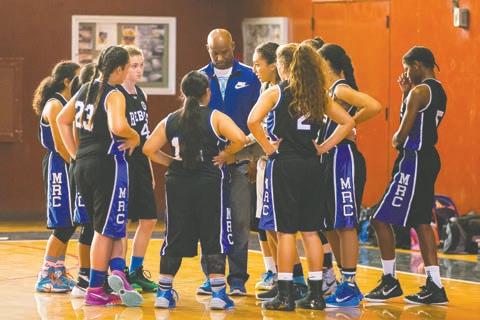

Lakeview resident Kim Gainer, an MRC volunteer for the past 15 years, has two daughters, Amber and Alani, playing for the club. Her oldest daughter, Ashley, also partook in the program, and currently attends Florida A&M University, where she’s participated in varsity and intramural teams. “People call MRC their home,” Gainer said. “The coaches and staff really care about the players. Everything has been about the girls. I can’t speak more highly of the coaches and staff. We have girls coming from American Canyon and Antioch; it’s amazing.”
MRC has been able to regain its
downward spiral it took follow-ing the death of Jimenez. Parents and players disheartened by his passing lost faith in the program; many left. Those who stayed were disappointed by interim leadership who wanted to do things their way, and focused more on rules and regulations than creating a supportive commu-nity. But some, like
REBELS page 27
 The Lady Rebels in action.
The Lady Rebels in action.
GARDEN
infertility or fertility losses. The second consisted of rabbis across the religious spectrum.
The concept of the Memory Garden sprung from conversations between Findling, a former Potrero Hill resident and philanthropic advisor for the Lisa and Douglas Goldman Fund, a private charitable organization; and Porth, associate executive director of the Jewish Community Relations Council, a public affairs organization that represents the Bay Area Jewish community. Findling and Porth discussed their past miscarriages and stillbirth, observing that Judaism afforded them few opportunities to memorialize their experiences.
“I was just surprised that in Judaism, which offers a safe protocol for grieving the loss of someone who has lived, there is a dearth of ritual for fertility losses,” said Porth. “I felt pretty isolated in the very natural process of grieving. I wanted to create a bridge to mourn fertility losses. I wanted and needed a space to do it.”
“Abby had this idea that we could create a place kind of like an AIDS memorial grove, where men and women could have a sacred place to reflect. We talked to Jewish community leaders. We received enthusiastic responses from rabbis across the Jewish spectrum,” said Findling.
The Garden will be the first project of its kind in the nation. There currently are no Jewish spaces where the bereaved can come or congregate specifically to grieve infertility and fertility loss. The presence of the Garden, and the opportunities it will afford individuals and groups to reflect, will create space for dialogue and the development of rituals related to such losses within the Jewish, and potentially other, communities.
Tax-deductible donations can be made to the Jewish Memory Garden Fund through the Jewish Community Federation, said Mark Reisbaum, senior director of philanthropic engagement for the Federation.
Rabbi Carla Fenves of Congregation Emanu-El, who participated in early discussions about the Memory Garden, said it’s important for Judaism to address infertility and fertility loss, especially because many Jewish women are starting families when they are older and, as a result, are more likely to experience fertility issues. Likewise, Orthodox sects of Judaism encourage large families, which can lead to fertility loss simply because the odds of it occurring increase as women age and engage in more pregnancies.
Patricia Gibbs, founder of and practitioner at the San Francisco Free Clinic in the Richmond District, has provided financial support for the Memory Garden. “I’m at the other end

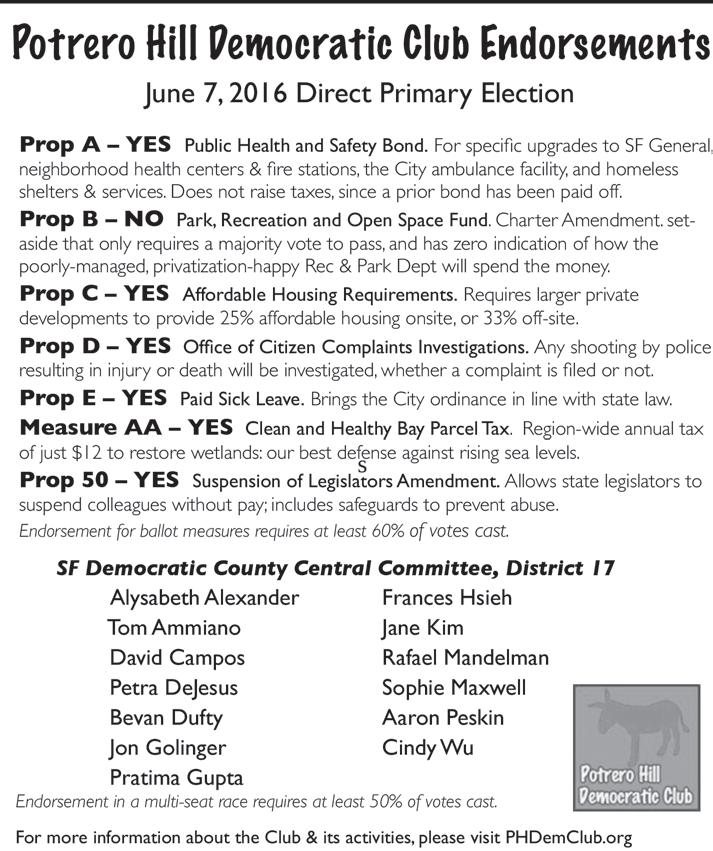
of the phone when people are calling with early pregnancy loss,” she said. “I’ve also been there as a resident when there is a late pregnancy loss. We didn’t have the resources to deal with it. It always seemed a glaring lack.”
Women who have experience a loss “…have to address it and work through it,” Gibbs continued. “In the meantime, the overriding rule is compassion and understanding. I really empathize with women who are going through this. I want to help provide the Memory Garden for them.”
“I think the more education, the more awareness there is, all of that will be very helpful,” said Susan Moldaw, who was joined by her mother and sister is providing financial support to the project. “The Memory Garden should be open to anyone going through this type of loss. My mother, sister, and I are happy this project is going forward.”
ELECTION from page 3
to expire in 2030, would be extended to 2045. The GF contribution would increase by $3 million annually until 2025, and by a percentage thereafter, except in times of fiscal deficit. And Rec and Park would have to analyze green space inequities in low income and disadvantaged communities. Parks and open space tend to get short shrift during times of economic trouble, and we generally like the idea of more green. However, ballot box budgeting isn’t our favorite public financing approach. And while the initiative permits expenditures on land acquisition, it’s unclear how “low income” or “disadvantaged” would be defined, and whether Dogpatch or Potrero Hill would qualify for a portion of the mandated funds to reduce our vast green space deficit. Our recommendation: Naybe.
Proposition C, Charter Amendment, Affordable Housing Requirements. Authorizes the Board of Supervisors to update inclusionary and affordable housing requirements associated with residential development, and establish interim mandates. Let’s be clear: this initiative, if passed, would neither solve the affordable housing crises, nor tamp down heated debates about how to do so. It will, however, excise affordable housing requirements from the Charter, whose existence makes the View think of a dusty document brought out by Springfield’s Mayor Quimby during times of Simpsonian conflict. But, we digress. Get it out of the charter, and into the hands of elected officials, who can then argue about it in sometimes entertaining, and perhaps even effective, ways. Our recommendation: Yes!
Proposition D, Office of Citizen Complaints Investigations. A police officer is involved in a shooting, OCC investigates. Works for us. Our recommendation: Yes.
Proposition E, Paid Sick Leave Changes the City’s paid sick leave ordinance to reflect recent alterations to state law. This is what happens when a municipality acts like a county-city-state; sometimes it has to change its laws to comply with
the actual state. Our recommendation: Yes.
Measure AA, San Francisco Bay Clean Water, Pollution Prevention and Habitat Restoration Program. Levies a region wide $12 parcel tax to pay for Bay Area wetland restoration. Since pretty much all of the Bay Area is going to be wetlands 100 years from now, thanks to those carbon emissions coming out of our cars, we may as well get ahead of the game. Seriously, wetlands are the Bay’s kidneys, plus home to many animals and plants. As a regional tax the City has less of an ability to extract the funds from its existing budget, as suggested for A. Our recommendation: Yes.
Proposition 50, Suspension of Legislators Amendment. Say you’re a state legislator, and you take a fat, or even stupid-sized, bribe from an FBI agent posing as an arms dealer. You get caught. Oh, oh! Your colleagues in the legislature can suspend you, eliminating your ability to cast a vote, and thereby charge for more bribes, but they can’t take away your salary. This proposition would allow the legislature to terminate the salaries and benefits of suspended legislators. Our recommendation: Hell, Yeah!
County Central Committees : OMG! So many candidates and not a single one knocked on the View’s door to ask for our endorsement, or even to take out an ad. Since they’ve ignored us, we’re choosing to ignore them. Our recommendation: Good Luck!
State Senate District 11: Both candidates, Jane Kim and Scott Weiner, will proceed past this primary to the November election, where the real decision about who will fill this office will be made. The View takes this opportunity to say, thanks, Jane and Scott, for engaging in the exhausting work of campaigning and representing. If you’re a Tom Ammiano fan, you probably should vote for Kim; if you prefer Mark Leno, like we do, go for Wiener. Oh, and speaking of which, worse political decision ever: Leno not running against Ed Lee in last year’s mayoral election. Mark, you’re doing great in the statehouse, but City Hall needs you! Our recommendation: Vote!
U.S. President : Heart against head? Or, with the Republican candidates, are other body parts involved? None of the remaining Republican candidates should be left unattended in the White House. Hillary Clinton has her flaws, and she can certainly be annoying, but she does have a certain gravitas, and is surrounded by enough experienced hands that she might do an above average job with a position that’s beyond difficult. Then again, we love Bernie Sanders’ tilting against the machine. Our recommendation: Close your eyes, take a deep breath, and make your best choice.
In addition to View publisher and editor Steven Moss, Potrero Hill residents Stacey Bartlett, Sasha Lekach, and Lisa Schiller Tehrani contributed to these endorsements.
The Meadow Circle at the memorial garden.While living on Potrero Hill, Debbie Findling found it challenging to have a second child. Her daughter, Sara, who weighed less than five pounds when she was born, was two-years-old. Before Sara arrived, Debbie had suffered a number of miscarriages, including a stillbirth. Her fertility woes continued after Sara’s birth.
“Like many women who experience fertility loss and infertility, I felt a sense of desperation,” she admitted. “I tried just about everything to have another baby. I went to gynecological specialists, herbalists, chiropractors, acupuncturists, and massage therapists. I even consulted a fertility witch.”
When Debbie’s aunt, Los Angeles resident Elaine Findling, heard of her dilemma she thought she might have a solution: Phyllis’ fertility doll. Phyllis was an old friend of Elaine’s who gave Elaine’s daughter-in-law, Melissa, an odd looking statue that Phyllis called a “fertility doll.” She’d picked it up in Arizona; she couldn’t recall when or exactly where. Elaine’s faith in the doll was sparked after Melissa got pregnant shortly after receiving it. “It must have worked,” said Elaine. “She got pregnant.”
Melissa’s pregnancy started a chain that solidified the fertility doll’s reputed powers. At least five women—all of whom were having serious fertility challenges—reported getting pregnant within a few months, if not weeks, after setting the doll on their bedroom dresser.
Debbie wasn’t one of them. After receiving the doll from her aunt, she held onto it for about a year, but its magic didn’t materialize. When her friend, Tiffany Shlain, confided that she too was having trouble getting pregnant, Debbie offered the small figure to her. “It didn’t seem to be working for me,” she said, “but I figured maybe it’d work for someone else.”
Shortly after receiving the doll, Tiffany became pregnant.
“While I had an easy time having my first child, I had a very difficult time having a second child. After going through five miscarriages, Debbie kindly lent me her fertility goddess,” said Tiffany, a former Hill resident.
After she received it, Tiffany, a filmmaker, was optimistic about the doll’s powers. “I was putting my hopes
everywhere and anywhere. I was making deals with the universe.... I'd like to think Debbie’s doll, working together with my fertility treatments, helped me have another child.”
Then there was Sara’s third grade teacher. Like Tiffany, she’d tried numerous interventions to conceive, including In Vitro Fertilization (IVF), with no success. Debbie passed her the doll from Tiffany.
Sara’s teacher was soon pregnant.
After she successfully gave birth, the doll went to another of Debbie’s friends, who prefers to remain anonymous. She too had tried IVF, with no success. After the figure arrived in her home she got pregnant; within a year she gave birth to twin girls.
Like all of the women in the chain, Castro District resident Danielle Foreman, the most recent fertility doll recipient, had found it challenging to conceive. She and her husband decided to use a surrogate. Debbie gave her the fertility doll, because “it couldn’t hurt and maybe it’d help her surrogate get pregnant.” Within a short time, Danielle’s surrogate was indeed pregnant. A couple of months later, so was Danielle. The surrogate is due in June, Danielle in August. Danielle calls them “twins, but not twins.”
“I didn't know about the fertility doll, but I did vaguely know about some of Debbie's fertility struggles,” said Danielle. “We were having lunch discussing several things, including fertility, when she mentioned the doll. My first thought was some kind of nice voodoo doll. She told me all the stories of women who had struggled to have kids for years, and once they had the doll they got pregnant.”
“The infertility/fertility journey is a mix of science and faith. You have no real control of the outcome, and because of that the only thing you can hold on to is hope. Hope that this time will be different; hope that the doctor finally gets it right; hope that God or whatever higher power out there finally sees your plight. So despite how illogical it may seem…I did have hopes that the doll would work. Even if the doll itself didn't work, I had something new to add to my hope list.”
Before getting pregnant Danielle had gone on a long journey to conceive. She tried acupuncture and herbs, Clomid – to help her ovulate – had a hysterosalpinogram – a fallopian tubal flush – Intrauterine Insemination, and

IVF. She’d seen a Reiki healer and a Balinese priest. She built a Kokopelli altar, featuring a Shiva goddess, sage and palo santo, and healing crystals. “My husband thought I started to believe in rocks and statues, but they kept me calm,” she said.
Not long after receiving the doll, the surrogate “was pregnant with our child!” exclaimed Danielle.
“Our pregnancy journey finally began. The level of PTSD I had was astonishing. I couldn't believe that this happened, she was healthy and it was going to work! The surrogate was about 15 weeks pregnant when I missed my period. I decided to take a pregnancy test – because every fertility patient never really gives up – and it was positive! I had for the first time ever conceived without medical intervention! My blood work and ultrasounds came back perfectly. It was a true miracle. Both of the babies are miracles. I think the power of meditation and mindfulness worked, and the fertility doll was a part of that.”

of the women she’s given the figurine to know one another. She’s their only link, and sole connection to the doll.
Debbie has rules for the doll. It must stay in the woman’s house for the full duration of the pregnancy, a practice that’s enabled her to pass the figurine on to four women over the past 12 years.
Even though the doll didn’t work for her, Debbie likes to believe she’s had a role to play in other pregnancies. None
Sara is now 14 years old. In the dozen years since receiving the doll, Debbie never mentioned to her aunt what she was doing with it. “I kind of don’t want to tell her because I don’t want her to ask for it back,” she admitted. “I want to keep using it for my friends.”
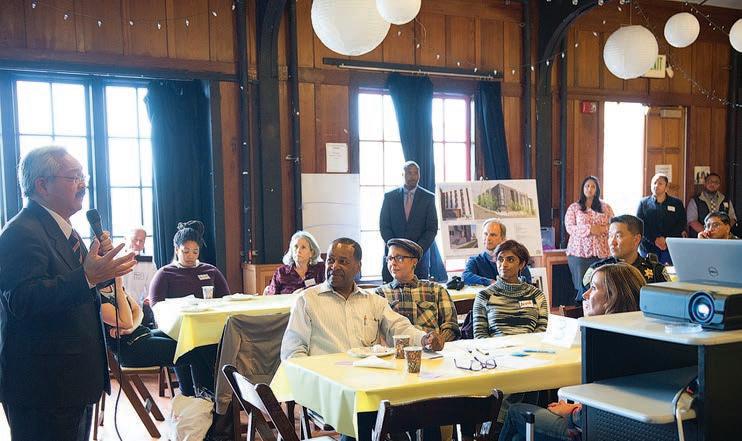
The NABE had a special guest on April 7, 2016,
attended community meetings at the four HOPE SF sites (Alice Griffith, Hunters View, Potrero, and Sunnydale) over the past month, bringing a message that reinforces his commitment to affordable housing in San Francisco. HOPE SF is an effort to rebuild SF’s more distressed public housing sites and transform them into thriving, mixed-income communities, while ensuring no loss of public housing and creating new affordable homes.
Mayor Lee grew up in public housing and knows firsthand the stigma of being labeled a “public housing resident.” He does not want public housing residents to continue to be viewed with disdain but rather to be treated as any other resident of San Francisco. “San Francisco is a prosperous city, and I want all its residents to reap the benefits of this economic good fortune...We are all San Franciscans, and you deserve the right to live in safe, clean, and decent housing.”
Rebuild Potrero, a comprehensive revitalization effort to rebuild Potrero Terrace and Annex public housing, will replace all 606 public housing units and create another 1,000 new homes with a range of affordability, community facilities, open space, and social networks and services to improve the lives of current and future generations in South Potrero.
Stay informed about Rebuild Potrero and other community projects. Come to the next Community Building Group meeting on June 2, 2016, 6 – 8 PM at the NABE.

Art Show Reception: All ages are welcome to the 58th annual Potrero Hill Artist Show reception! View artwork by neighborhood artists and enjoy musical entertainment by Clifford Brown III. Saturday, May 7, 6.30 to 9 p.m.
Parent Education Workshop: These workshops will explore the challenges of raising children, and provide parents a safe place to share stories and experiences, learn coping techniques, and identify ways to build strong relationships with children. Childcare provided. Wednesdays in May, 3 to 5:30 p.m.
Creativity and Art Group: Express your creativity through art, music, meditation and more! Led by Cat Ehisen, family counselor at the Potrero Hill Family Support Center (PHFSC), this all-ages program meets every Friday, 1:30 to 2:30 p.m.
Movie Night: The Wedding Banquet: In celebration of Asian Pacific American Heritage Month, join us for a screening of The Wedding Banquet, directed by Ang Lee. 1993, R, 108 minutes. Wednesday, May 11, 6 to 8 p.m.
Screen Time: Hoopla: Find out how you can read, watch, and listen from your portable devices in this quick overview of Hoopla. Bring your laptop, tablet or smartphone for a hands-on demonstration of this awesome free service. Saturday, May 21, 2 to 3 p.m.
Harnessing Happiness: Join psychotherapist Dr. Asya Grigorieva as she teaches you how to choose happiness. This presentation provides an overview of Positive Psychology and the techniques that can lead to a happier, more fulfilled, life. Saturday, May 28, 2 to 3 p.m.
Game On!: Play video games on our big screen in the Potrero meeting room! Ages eight to 18 welcome. Tuesdays, 4 to 6 p.m.
Washi Tape Extravaganza: Join us to explore creative possibilities with a variety of colored and patterned washi tapes and get into this trendy Japanese craft! We'll provide notebooks and pencils to decorate, or bring your own gear that could use a splash of style. For all ages. Wednesday, May 4, 6 to 7 p.m.
Saturday Snacktivity: With food provided by The Good Life Grocery, we’ll offer a wholesome snack followed by a fun activity. All ages welcome. Saturdays, 11 a.m. to 12 p.m.
Baby Rhyme and Play Time: Songs and rhymes for infants up to 18 months old and their caregiver(s). Tuesdays, 1:15 p.m. and Thursdays, 11:15 a.m.
Family Story time: Featuring stories, songs and rhymes. For children from birth to five years old and their caregiver(s). Thursdays, 10:15 to 10.45 a.m.
Decorate Holiday Cookies!: Decorate plain sugar cookies with icing, sprinkles, and more! Bring a container so you can take your cookies home. Parents are welcome to join in! Saturday, December 5, 2 to 3:30 p.m.
Puppy Dog Tales: This SPCA program pairs trained dog-and-owner therapy teams with children to grow little ones’ literacy, self-confidence, and socioempathic skills. Your child will adore reading to this calm canine companion in a non-judgmental setting! For ages four to eight, but older welcome. Call 415.355.2822 to reserve your spot. Space is limited. Fridays, May 6 and May 20, 3:30 to 5 p.m.
Lego Build Afternoon: Get creative building with LEGO. We provide all the pieces you'll need to create vehicles, robots, castles, and more. Saturday, May 14, 4 to 5 p.m.
Movie and Meal Day: In partnership with PHFSC, Lilo and Stitch. Rated PG. 85 minutes, accompanied with a meal. Friday, May 20, 3 to 5 p.m..
Candy Leis! Learn to make a scrumptious candy lei! This gift is perfect for graduations, birthdays, party favors, or to show someone that you care. We’ll also talk about the culture and history of leis. All materials provided. Children five and under may need adult assistance. Saturday, May 21, 4 to 5 p.m.
COSMETICS from page 18
partners are ready and eager to provide these young people with high-quality, youth-friendly care,” said Ayanna Bennett, MD, interim medical director of Community Health Programs for Youth for the San Francisco Department of Public Health. “We want to be sure young people know that they are welcome in clinics all over the City and that they do have access to the care they need.”
3rd Street already serves many young Potrero Hill residents, but Jackson-Morgan is worried that with no other youth-specific clinics in the immediate area, New Generation’s closure will leave some of its patients without access to health care services. "We've been on the forefront fighting for NewGen, being that it's going to create a huge disparity in the community and there hasn't even been a community assessment done," Jackson-Morgan said. “We literally moved a few blocks from here and had to start our outreach six months ahead of time and it still took a year for us to get our old patients back, so for them to think that youth are going to be able to look at a list and pick out a physician is unreasonable.”
School health workers have also opposed the closure. According to Jody Tsapis, the wellness coordinator at Downtown High School, on Vermont Street, for her students NewGen is the “go-to clinic for sexual health and sensitive services. Right before they announced the closure, Tino Ratliff [NewGen’s outreach and education coordinator] had presented birth control/
pregnancy prevention and STD education workshops to our entire school, class by class. After the presentations, our Wellness Center saw a clear uptick in students asking for appointments at New Gen…Other clinics may be able to provide similar services, but it is their approach to this population that creates trust and support to youth who need it the most.”
At least two young patients of New Generation hadn't heard of the clinic’s impending demise. One of them, Pheona Gaynor, has been going to NewGen since she was referred there for reproductive care by the health center at John O'Connell High School when she was 16. "I'm disappointed, I didn't even know that. You just told me. I came here a few weeks ago, and my doctor, favorite person there, she didn't even mention it," Gaynor said. "I do go to UCSF, but this one was always convenient for me. It's going to be really weird because I'm going to have to make an appointment and it's going to be a hassle."
According to Woodruff, when it comes to buying safe products in today’s regulatory environment, consumers have to look out for themselves. “People have to be empowered to make the best choices they can make, but they also need to be able to tell the government so that they control the sources before people go to the store and try and sort through all these labels,” she said. “But really, you should be able to go to the store and buy products and not have to worry about whether they are safe or not, right? I mean it sounds so illogical when I say it, but yet that's the way it is right now.”
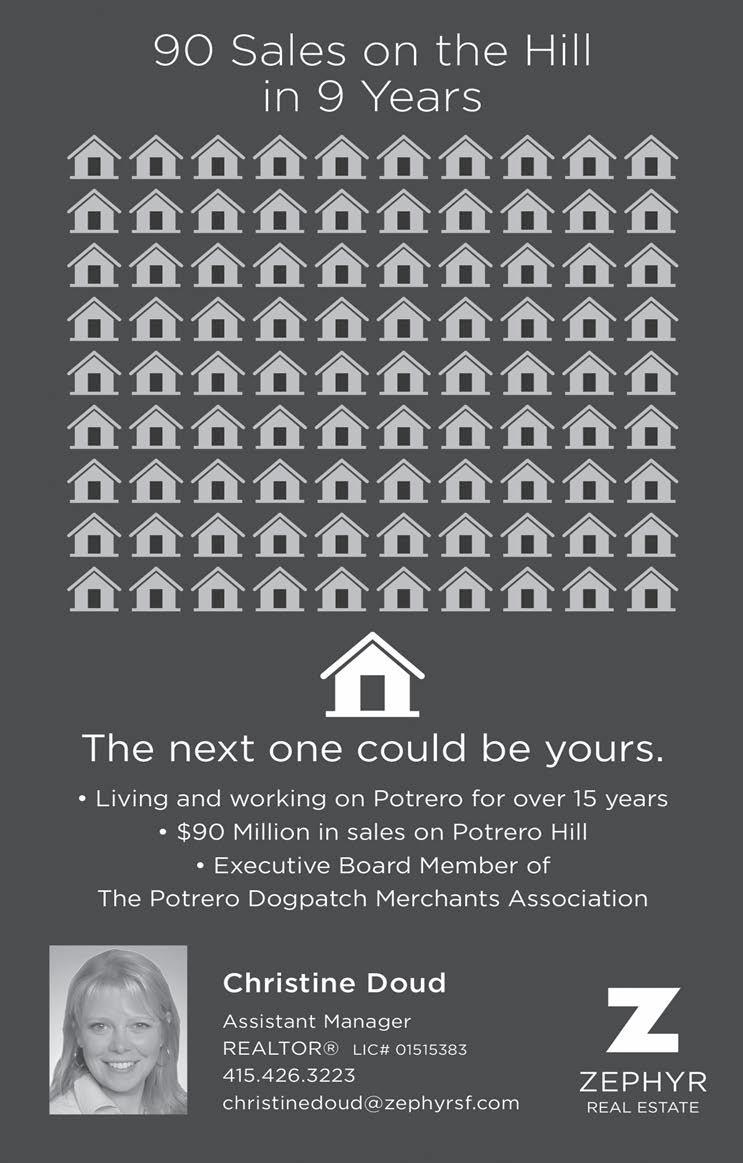
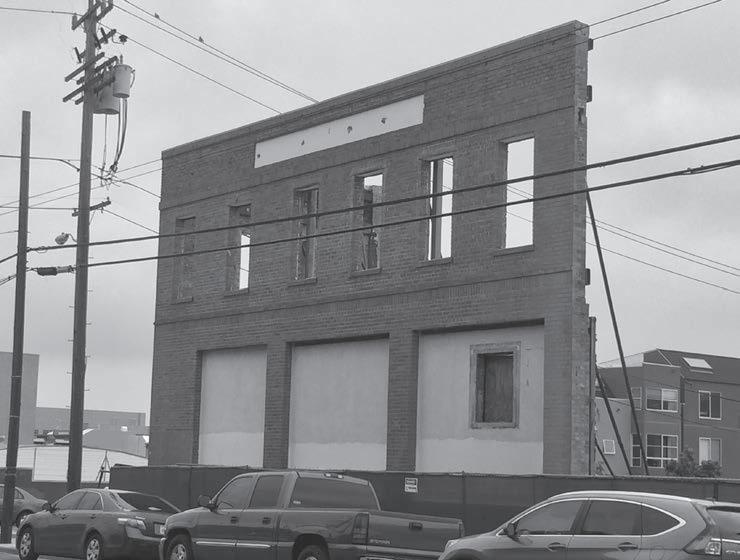
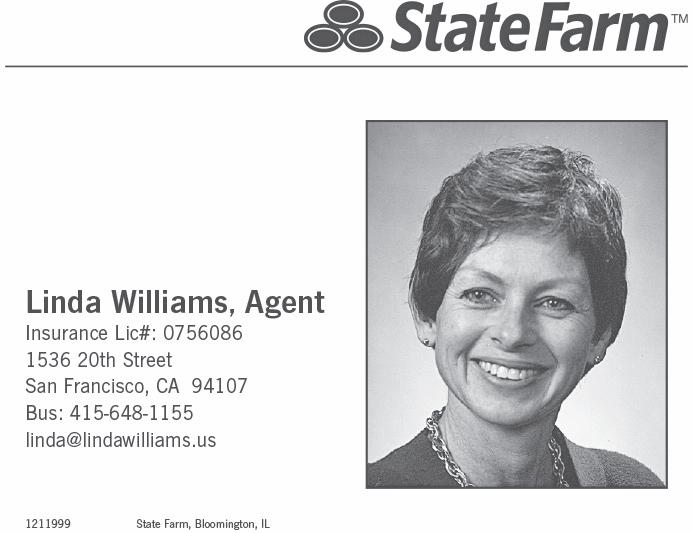
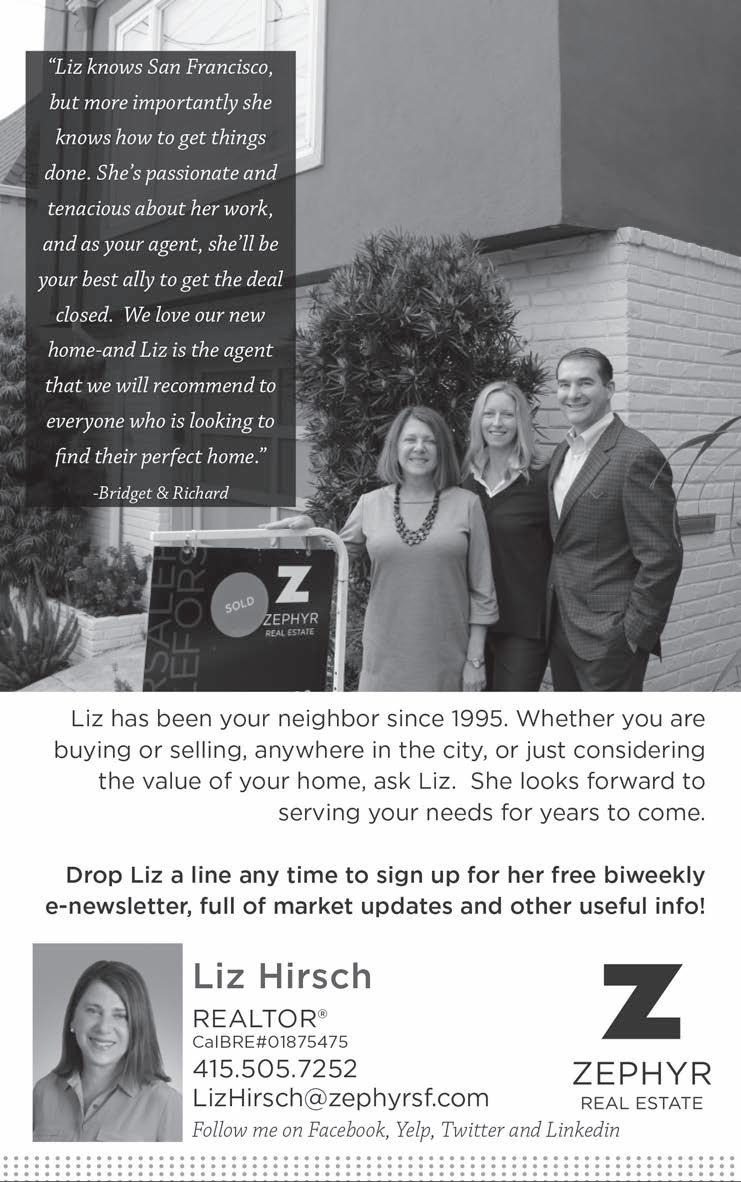

by limiting the amount of time nonresidents can park in designated areas. A petition signed by more than 50 percent of households on a block must be submitted for an area to participate in the program.
SFMTA and Dogpatch residents and businesses generally agree that the neighborhood needs more parking regulation. Dogpatch’s increasing population density, with residential complexes replacing formerly industrial land uses, has led to intense space shortages for residents, workers, and commuters. Developments surrounding the neighborhood, such as the University of California, San Francisco-Mission Bay, as well as impending Pier 70 redevelopment and the siting of the Golden State Warrior’s Arena, will add to the pressure. SFMTA’s current initiative aims to study whether or not RPP, as it’s currently structured, fits with the City’s livability goals.
“We’re trying to look at the immediate issues and two to ten years in the future,” said Hank Wilson, SFMTA manager of parking policy. “There’s more development coming and not every unit of housing is going to have a parking spot. This is going to attract more people who are interested in living a car-free lifestyle.”
A Dogpatch resident since 1985, Edward Elhauge owns and occupies a building at Tennessee and 22nd streets. He was part of a group that opposed a 2012 SFMTA pilot project that also involved adding paid park-
ing. “It’s difficult to deal with both the SFMTA and the DNA leadership because they don’t seem to care about people who have lived here for a long time,” Elhauge said. “I’m concerned about the displacement of people who live here and still need cars to go to work or take their kids to school.”
SFMTA is analyzing 2,310 parking spots in the area. The current proposal includes an experimental RPP-meter overlay, which would add paid parking for non-residents at spots that also carry RPP. As many as 626 RPP-meter overlay spots could be added in areas north of 19th Street, including on Indiana, Minnesota, Tennessee, Third, and 18th streets. Additionally, 615 time-limited spots and 423 paid spots could be added between 19th and Cesar Chavez streets. The proposal would reduce unregulated parking by 1,748 spots, leaving only 100 unregulated spots in the area. Proposed changes to parking regulations on 22nd Street are pending.
According to Hank Wilson, SFMTA is still getting input from DNA, neighbors and business owners; the proposals are tentative and subject to change. Still, some residents are concerned that after the pilot project is over the RPP will be removed, with just the paid parking retained.
“It’s evolving into a parking management plan,” Wilson added. “We don’t want to force anything on anyone. We want to work with the community. Almost every neighborhood would benefit from updates, so it’s more about finding the neighborhoods that are interested. The Dog-
patch seems like an interesting place to try out some new parking ideas.”
Though meters are one of the easiest regulations to enforce, people often have a negative initial reaction to them. “Meters are a scary word for everyone,” Wilson clarified. “If we are going to move forward, paid parking is a more acceptable way to describe it. We would like to add paid parking without physical meters so that we won’t have to take the meters out if the pilot doesn’t work.”
Nicky Jacobson, a Tennessee and 18th street resident, is organizing northern Dogpatch residents to oppose the RPP-meter overlay proposal, outlining her concerns at enufsf.com.
“RPP is done by petitioning the block to get over 50 percent resident support. With this pilot program, they’re not doing it by petition process. This enables the SFMTA to have license to do whatever they want in any neighborhood they want,” Jacobson said.
She believes that with all of the high-rise residential development, the neighborhood will need new regulations within the next two years. One strategy could be to make all RPP spots for northern Dogpatch one-hour time limited for nonresidents. She added that the RPP renewal process should be weighted in favor of existing residents, who could have access to permits before those moving into new construction, arguing that the recent arrivals are aware of parking shortages and can more easily opt out of car ownership. Jacobson would also like to change RPP eligibility to include both businesses and residents, to help local
merchants stay afloat.
Elhauge hopes to be able to continue to live in the neighborhood and that other long-time residents won’t get pushed out by the paid parking regulations. “The people who are pro-meter say that they’ve managed to live without a car by taking Uber,” he said. “There’s not a lot of compassion for those with limited incomes, the elderly, families, or disabled people. We’ve been told we should just move out of the neighborhood if we don’t like it; that’s shocking to me. Here in the Dogpatch we don’t even have a grocery store nearby within walking distance.”
According to Elhauge, a better way to manage the parking shortage than monetizing street parking would be to create commuter lots on Iowa Street next to Caltrain. “Basically, what it comes down to is that our neighborhood can deal with its own activity but can’t deal with being the parking lot for public transit commuters,” Elhauge added.
In its effort to evaluate the RPP program, SFMTA will be gathering data on parking demand, effectiveness of alternative transportation options, and parking supply, both on and off-street. Despite some residents’ desire for more off-street parking, that element won’t be included.
“SFMTA is not in the business of building parking lots or garages. We want more people to walk, take transit, and bike,” Wilson said.
This is part one of a two-part series.

Frederick H. Van Dusen, longtime resident of Potrero Hill’s northwestern slope, passed away of natural causes on Wednesday, March 16, 2016, at the age of 81. Van, as he was called by friends and family, was a vibrant neighborhood fixture for nearly 60 years, having moved to the Hill in the late-1950s after completing his tour of duty with the United States Coast Guard. Van Dusen went on to become a successful mortician, working for Duggan's Serra Funeral Home on 17th Street between Valencia and Albion, where he attended to the care of many Hill and Mission district families grieving the loss of a loved one.
An 18th and Vermont streets resident, Van Dusen was a friend to many. A born raconteur with a gregarious personality and a formidable sense of the absurd, Van was master at storytelling, sharing a seemingly endless stream of tales detailing hilarious accounts of adventure and misadventure. During his many years living on the Hill, he was a frequent patron at the Potrero Branch of the San Francisco Public Library. For several years following his retirement, he stood behind the counter at Dave’s Food Store on 20th Street, entertaining customers with his asides and droll humor.
Van Dusen was an avid collector of memorabilia and commemorative items, and amassed an impressive collection of Waterford Crystal, much of which was purchased directly from the manufacturer in Ireland. He volunteered at the San Francisco Veterans Hospital, where he devoted many hours.
Frederick Van Dusen left behind many nieces, nephews, and old friends. At his request, his ashes were scattered on Tuesday, March 22, 2016, at a Military Funeral with Honors held at the Sacramento Valley Veterans Administration National Cemetery in Dixon, California.
GOLD from page 16
Nash followed by clapping his hands over his eyes.
“Stupid monkeys,” Stephanie suppressing a giggle. “Lack’s cells did something unexpected. They grew. Before, cells made from other cells survived just a few days. Scientists spent more time trying to keep cells alive than doing research on them. HeLa cells didn’t die; they could be used for lots of experiments. Jonas Salk used HeLa cells to develop his polio vaccine. These days they’re central to cancer research, gene mapping, all kinds of bio-inquiries. There’s like 10,000 patents involving HeLa cells.”
“Is this, real?” asked Justin, working hard to concentrate. “I mean, true?”
“Yes, it’s absolutely true. And it’s why we want the property.”
“Why?” asked Justin. “I mean, I get that these cells are really valuable. And another example of White power ripping off African-Americans, by the way. But what does that
have to do with the property?”
“The property used to have an apartment building on it. It burned down after the 1989 earthquake under mysterious circumstances. A few tenants died. We think one of them was Henrietta Lacks’ father.”
“Lack’s father?” echoed Jordan. “I lack a father, too. Mine was a real asshole.” He turned to Justin. “Will you be my daddy?”
“Later,” said Justin, reaching over to squeeze Jordan’s arm. “So what?” he stared at Stephanie. “Lack’s father died there. Why does that matter?”
“Because,” Stephanie said, as she wriggled off the bean bag chair and stood up. “We think his body, or what’s left of it, is still there. We want to harvest that material, and create an even more potent cell line.”
“Ka-ching!” yelped Jordan.
Each month the View publishes a chapter from Gold, a serialized tale of politics, capitalism, and corruption in San Francisco. Previous chapters can be found on the paper’s website, www.potreroview.net.
CELEBRATE YOUR CHILD’S MILESTONES: The View is pleased to publish photographs and captions feting birthdays, graduations, sports achievements and the like. Send yours to production@potreroview.net
FREELANCE WRITERS: The View is looking for writers, with fee-based compensation provided. Contact: editor@ potreroview.net
CLEANING PROFESSIONAL 28 years experience. Apartments, homes or offices and apartment buildings. Roger Miller 415-794-4411 References upon request. Computers
COMPUTER PROBLEMS DRIVING
YOU BUGGY? Personal IT consulting for small businesses & busy professionals. Problems fixed! 30+ years experience. I can install & troubleshoot as well as shop for computers/networks/printers. If you’re not technical, don’t worry – I am. Rob 415.935.3305. rob@sfcomputech.com
LOOKING FOR…producer/director(s) to help with an original murder mystery musical, to be performed at and for the benefit of the Potrero Hill Neighborhood House. Please call or text Lorys Crisafulli, (415) 471-4284.
I’ve been teaching piano at The Voice Studio on Missouri Street. We were recently forced out by the landlord. I’m looking to rent a room for teaching in the neighborhood every Thursday between noon and 7 p.m. Randy Craig, randycraigpiano@ gmail.com

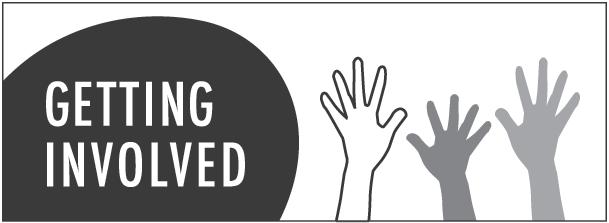
Potrero Dogpatch Merchant’s Association meets the second Tuesday of each month at 10 a.m. at Goat Hill Pizza, corner of Connecticut and 18th streets. Website: http://pdma-sf.org/. Call 415.341.8949. Next meeting: May 10th.
Starr King Open Space meets for monthly Stewardship Day the second Saturday of each month from 9:30 a.m. to 12:30 p.m. at Starr King Open Space, corner of Carolina St. and 23rd St. Come out and meet your neighbors, be a community steward, enjoy the natural grassland habitat, see spectacular views, and celebrate our beautiful neighborhood open space. Everyone is welcome. Find out more at starrkingopenspace.org or facebook.com/ StarrKingOpenSpace.
SOMA Rotary Club meets the second and fourth Thursday of the month at Mission Rock Resort, 817 Terry Francois Blvd. We meet at 6 p.m. for a mixer and 7 p.m. for a dinner meeting. We provide community service to the Mission Bay, Potrero, and Bayview communities. The focus is on providing services for the under-served of our community. The website is located at: http://www.meetup.com/Mission-Bay-Rotary-Club. For more information contact Nine at: n.ladow@comcast.net.
Potrero Hill Garden Club usually meets the last Sunday of the month at 11 a.m. for a potluck in a local home or garden. We occasionally visit gardens such as Ruth Bancroft, Yerba Buena, Cornerstone, Filoli, and the rooftop garden at the Fairmont. We discuss gardening appropriate for Potrero Hill’s microclimates, and often have speakers on subjects such as drought, wind, shade, pests, and even flower arranging. Call 415.648.1926 for details.
Dogpatch & Northwest Potrero Hill Green Benefit District meets the second and fourth Wednesday of each month from 6:30 PM to 8:00 PM in the Tivoli Room at UCSF, 654 Minnesota Street. Our mission is to clean, maintain, enhance, and expand open spaces, parks, plazas, parklets, gardens, sidewalk greening and the public realm in general in the Dogpatch and Northwest Potrero Hill neighborhoods; support community and volunteer efforts; and promote sound ecological practices and green infrastructure with a locally controlled, sustainable and transparent funding structure. Next meeting is May 11th. Visit our website to see what we are working on near you! www.dnwph-gbd.org
of premature death in men. Today, it’s an almost unnoticeable element in mortalities.
When health officials discuss mortality rates and causes of death, they often speak about “Years of Life Lost,” or YLL. YLL is an appealing metric because it doesn’t just measure how many people die due to a given illness, or how old individuals were when they passed. It gauges the “burden of premature mortality” on a population. It’s a way to give greater weight to deaths that occur at younger ages than those that take place when people are older. In short, it’s the red flag of death.
From 2000 to 2007 the number of YLL due to HIV/AIDS in San Francisco dropped from almost 24,400 to around 17,600. That steep decline has continued, with the number of people living with Stage 3 HIV – AIDS –growing significantly, according to the City's most recent epidemiological data. In addition to prevention, the decline in HIV/AIDS-related deaths is largely the result of advances in medications. The disease has largely been defanged due to the increased use of anti-retrovirals, the advent of protein inhibitors and the more frequent use of genotyping, a way to identify the particularities of a virus that indicate how it could mutate to become resistant, allowing physicians to target it directly.
According to T.J. Lee, program manager at Positive Force, a project of the San Francisco AIDS Foundation, these advances drastically
changed how San Francisco’s HIV/ AIDS community saw a diagnosis. “I knew people that were a month away [from death]. They had everything set up. They had paid for the funeral. They had given all their possessions away and then all of the sudden, their doctors—last chance—they were like, ‘Here, try these meds,’ and they’re still alive today,” Lee said.
While fewer San Franciscans are contracting HIV/AIDS, and even less people are dying prematurely of it, Black San Franciscans are disproportionately affected by the disease, with higher rates of infection and lower probabilities of survival. According to Lee, the Hill is a prime example of this stratification. “Potrero is an interesting little microcosm to look at because Portrero has virtually no cases of HIV and AIDS on the northern side of the slope, but you go on the southern side of the slope and there’s a huge, huge community of HIV-positive people that live there. And it’s a disproportionate number, because if you look at the population breakdown by ethnicity throughout the City—I think African-Americans —they represent about six to eight percent of the population, but they represent around 11 percent of the infections,” he said.
Higher death rates from HIV/ AIDS extend to how Black San Franciscans fare when it comes to virtually all of the City's leading causes of death. While CDPH data shows life expectancy for San Franciscans hovers around 82 years of age for the city-as-a-whole, life expectancy for Black San Franciscans lingers at
roughly 71 years.
As many City residents live into their eighties another notable shift is occurring: Alzheimer's and other dementias are increasing significantly as a cause of death. In addition to debilitating the brain, these diseases impair a person's ability to cope with infections and other physical problems. Between 2000 and 2007, the number of men who died due to Alzheimer's and other dementias almost doubled. CDPH data shows deaths have grown exponentially ever since. Roughly twice as many women have died of dementias than men in San Francisco since 2000. While the number of women dying of dementias increased less rapidly than that of men during the early aughts, death rates from the disease are now quickly rising for both genders. This was evidenced in 94107, at least through 2007. From 2000 to 2003, twelve women died of some form of dementia, whereas from 2004 to 2007, that number jumped to 16. It's important to note that sample sizes for death rates when broken down by zip code are too small to draw broad conclusions.
With HIV/AIDS death rates down, Alzheimer's, dementias and other nervous system disorders are now the third most prevalent killer, after heart disease and cancers. They’re responsible for nearly 10 percent of deaths in San Francisco. The challenge now facing the City is how to ensure that the management of those illnesses — access to care and prevention —proportionately benefits all segments of the population.
REBELS from page 20
Gainer and her daughters, stuck with the program. Over time, players who had left rejoined the club.
An evaluation system is in place that allows parents and coaches to monitor the pro-gram’s quality; feedback has been positive. MRC has more than 100 players and four teams, with games scheduled for Portland and Chicago this July. Competitions are mostly in the Bay Area but once a season a tournament will often be held in Reno or Anaheim. The high school team travels further, including to Las Vegas and San Diego during the summer to showcase their skills in front of college coaches and nationally-ranked competition.
Even after spring tryouts — to evaluate players’ skill level, sportsmanship, and focus — girls are encouraged to join the club, with program staff conducting outreach to local schools. “We feel that there are girls who still feel they don’t have a place to go and want to be part of a supportive community,” Hodges said. MRC doesn’t make cuts and accepts players of all levels.
For Reppert, MRC basketball is much more than about winning games and college scholarships. He wants the program to have a family atmosphere, where the focus is on educating girls to love the sport and gain life lessons that can be used on and off the court. “Word of mouth has really spread the program,” Reppert offered. “We understand that this is a journey, not a destination that will be reached overnight.”



















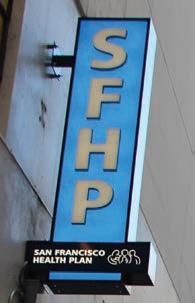 MORTALITY from Front Page
MORTALITY from Front Page







